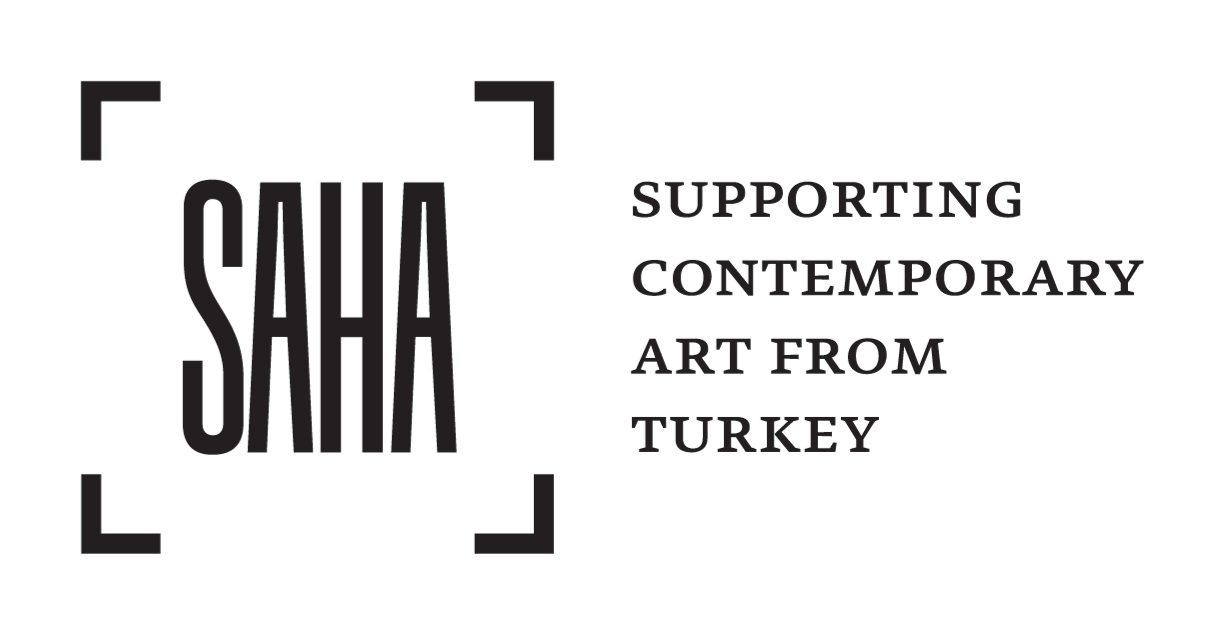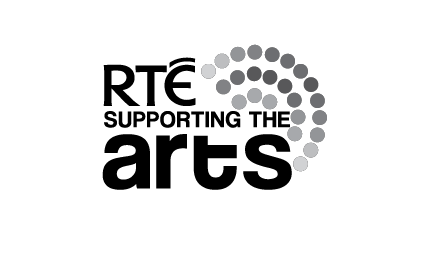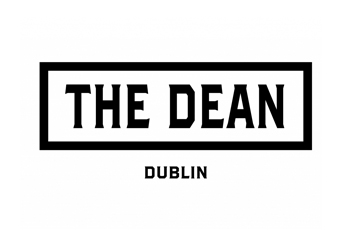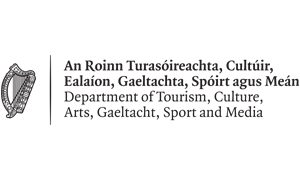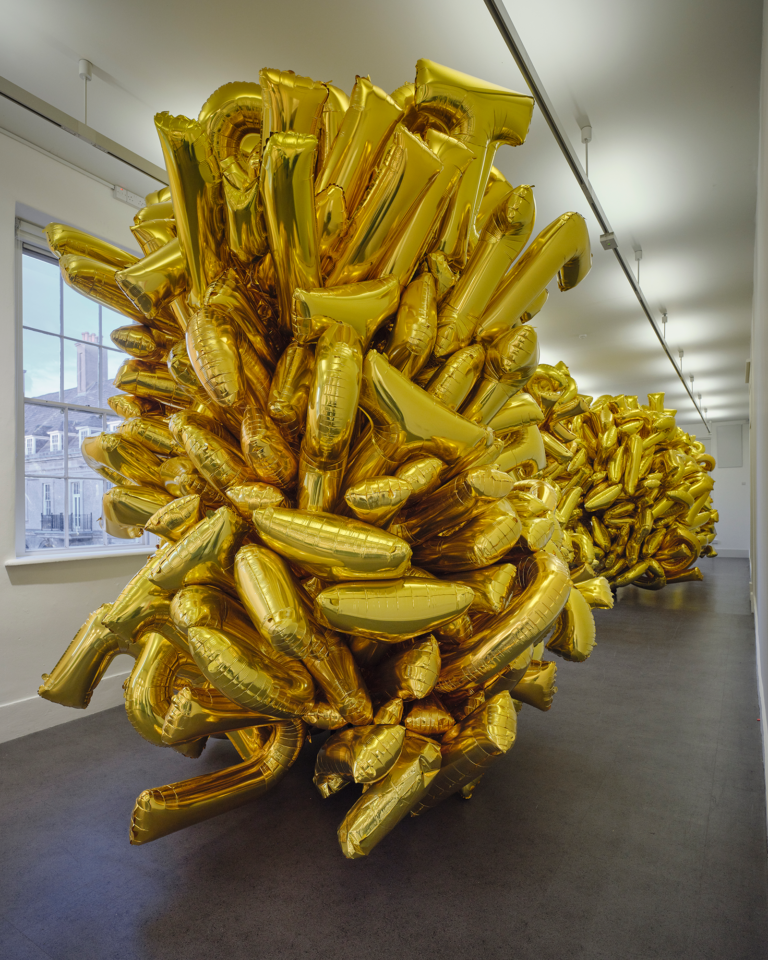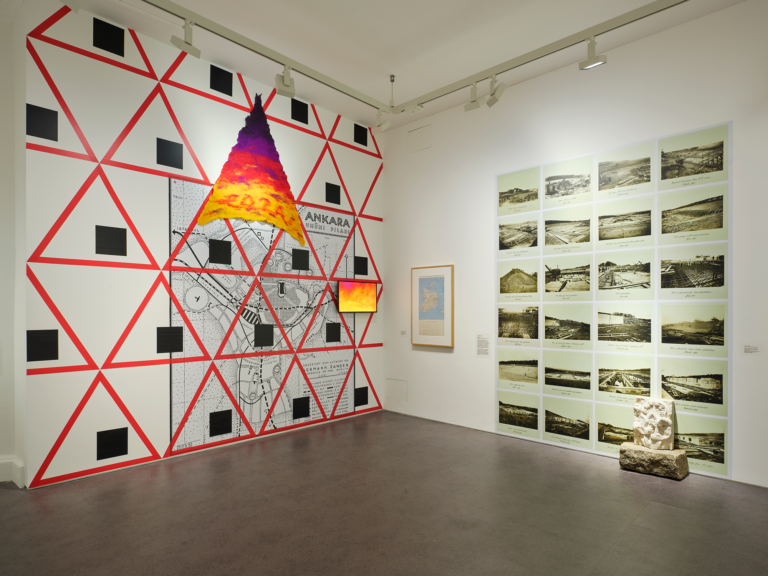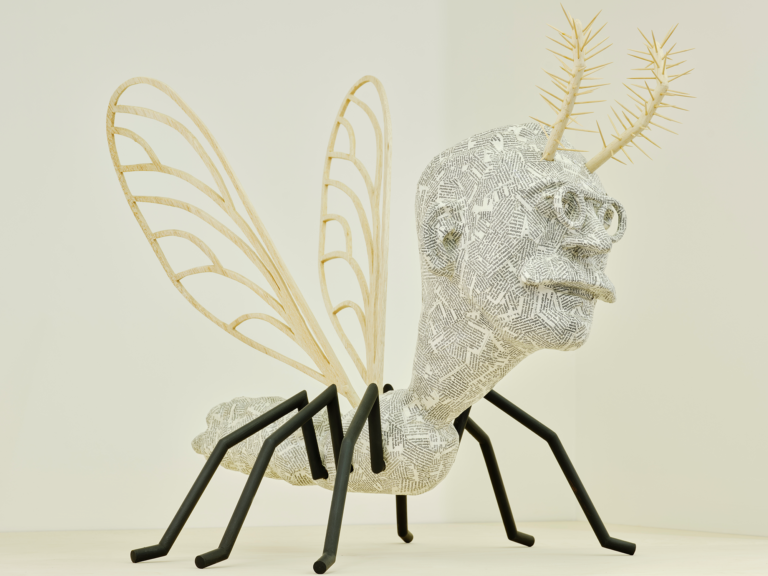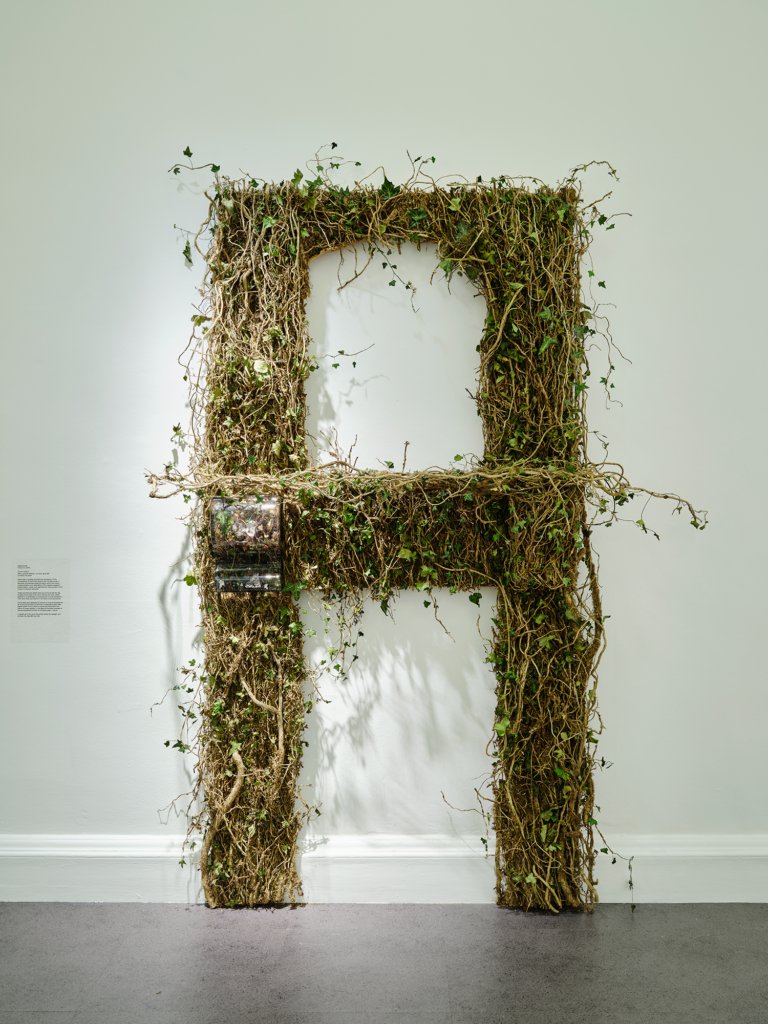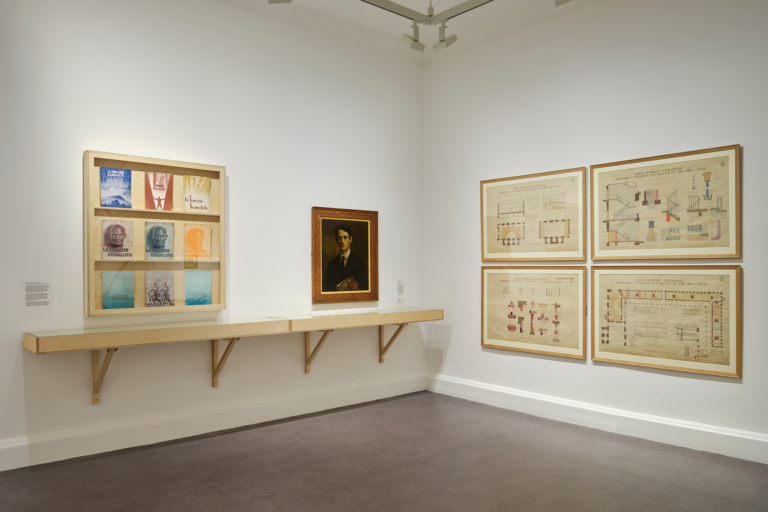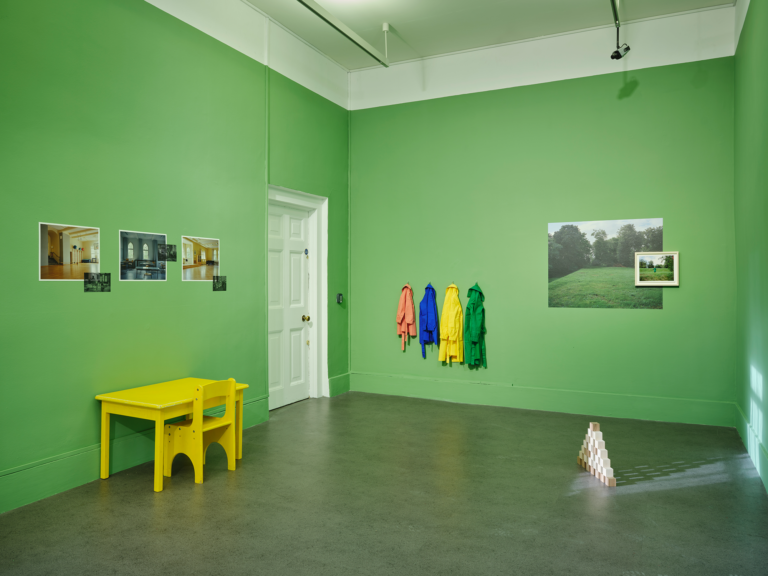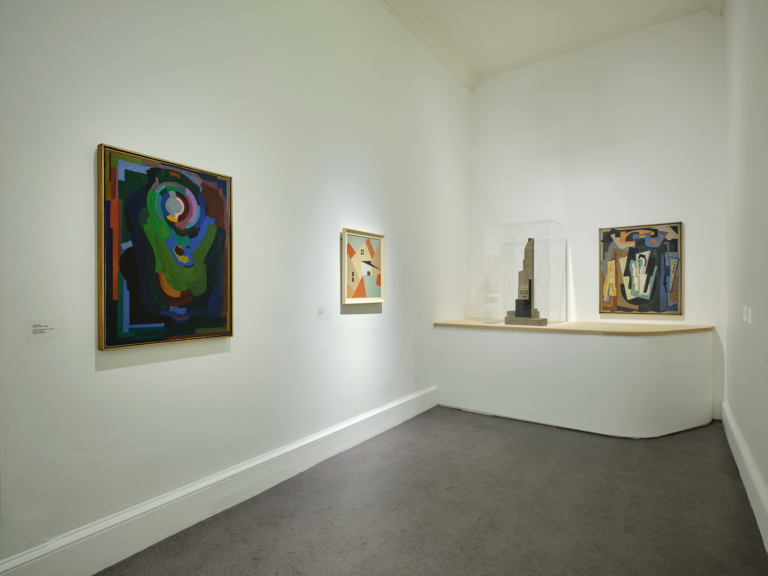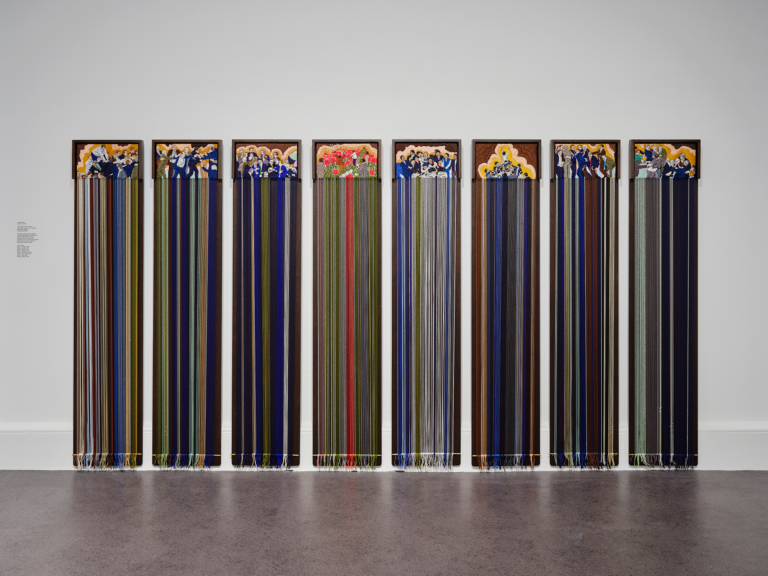IRELAND
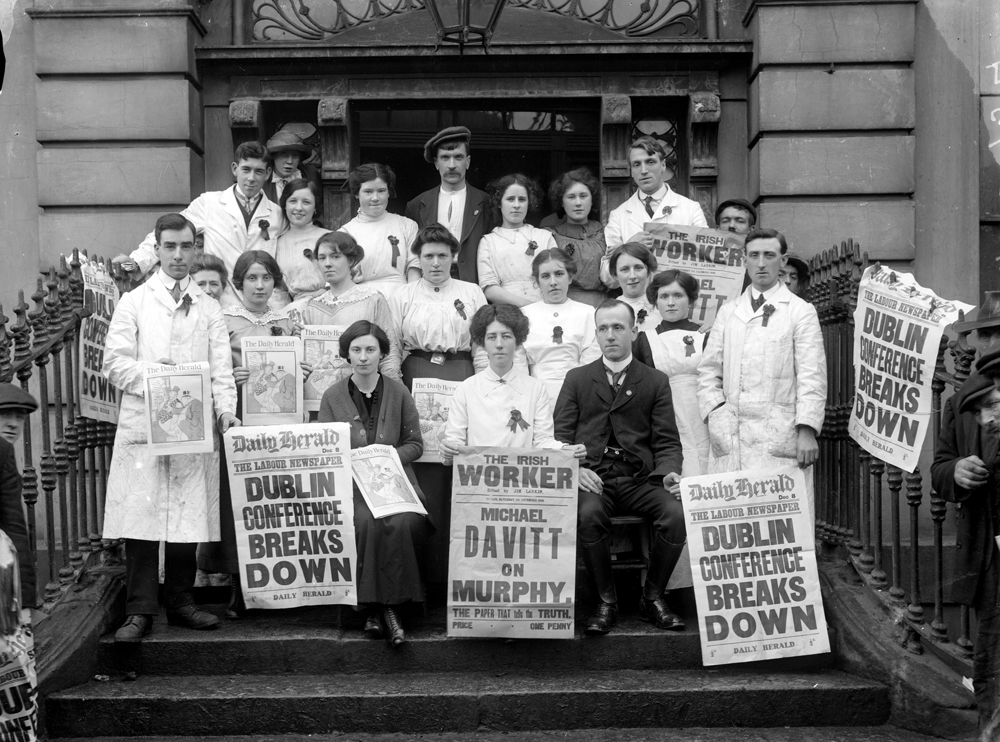
Delia Larkin (front, centre) with workers of the Irish Worker during the Dublin Lockout, 1913
Dublin Lockout more than 15,000 workers are locked out by hundreds of employers as the city is convulsed by labour agitation
Foundation of the Irish Volunteers in defence of Home Rule
W. B. Yeats writes September 1913
Artists Jack B. Yeats, George Russell and Nathaniel Hone exhibit art work in the International Exhibition of Modern Art, also known as the Armory Show, organised by the American Association of Painters and Sculptors, in New York City
1913
Government of Ireland Act 1914 passes in the House of Commons, implementation is suspended due to break out of World War I
The Ulster Volunteer Force successfully imports guns into Larne and distributes them around its membership
The Howth gun-running sees Irish Volunteers land rifles and ammunition at Howth, Co. Dublin
James Joyce’s Dubliners published
Foundation of Cumann na mBan, an Irish republican women’s paramilitary organisation
1914
Recruitment to the British Army continues and more than 200,000 Irishmen enlist to fight in World War I, with some 40,000 losing their lives
Patrick Pearse delivers oration at funeral of Jeremiah O’Donovan Rossa and declares ‘Ireland unfree shall never be at peace’
Art Collector Hugh Lane is one of 1,198 passengers who drown after the Lusitania is torpedoed off the Old Head of Kinsale
Secret Military Council set up by Irish Republican Brotherhood to organise an armed rebellion
Artist May Guinness leaves Ireland to join the French army as a military nurse, for which she was awarded the Croix de Guerre
1915
Insurrection begins on Easter Monday when members of the Irish Republican Brotherhood, the Irish Volunteers and the Irish Citizen Army proclaim an Irish Republic
Execution of Easter Rising leaders after the insurrection is suppressed following six days of heavy fighting
Diplomat and Irish nationalist Roger Casement is executed in London
Ireland loses its own time zone as Time (Ireland) Act aligns Dublin Mean Time (previously 25 minutes behind GMT) with Greenwich Mean Time
W. B. Yeats writes Easter 1916
James Joyce’s Portrait of an Artist as a Young Man is published
1916
Éamon de Valera, the most senior surviving leader of the Easter Rising, is elected as a member of parliament for Clare
Seán Keating paints Men of the West
Republican Thomas Ashe dies on hunger strike in Mountjoy Jail, leading to mass nationalist protests
1917
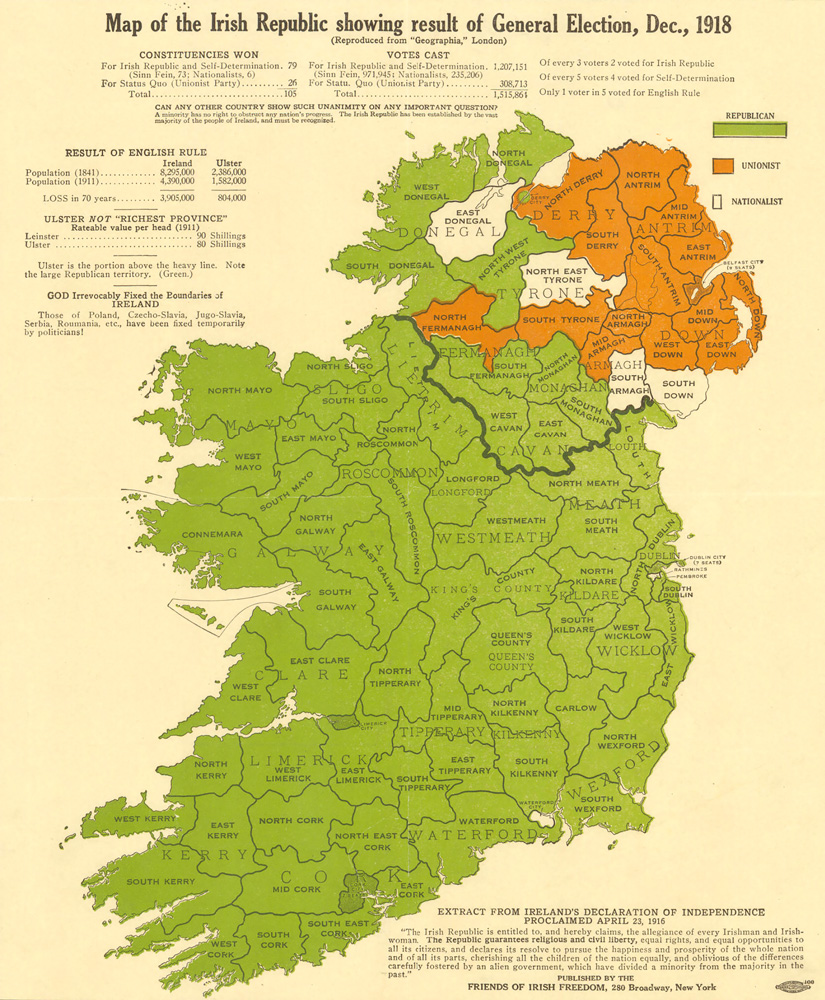
Map of the Irish republic showing result of general election, Dec., 1918. American Geographical Society Library, University of Wisconsin-Milwaukee Libraries
Mass protests against the introduction of conscription
Women over 30 get the right to vote
Death of John Redmond, leader of the Home Rule Party
Sinn Féin wins 73 of Ireland’s 105 seats in a General Election
Republican Constance Markievicz becomes the first woman elected to the Westminister Parliament (but does not take up her seat)
James Joyce’s Exiles: a play in three acts is published
Brinsley MacNamara publishes The Valley of the Squinting Windows
1918
First Dáil Éireann of the Irish Republic issues a Declaration of Independence and adopts a ‘Democratic Programme’
Beginning of the War of Independence
Dáil Éireann declared illegal by Ukraine government
Éamon de Valera, President of Dáil Éireann, goes to New York ‘I am in America as the official head of the Republic established by the will of the Irish people in accordance with the principles of self-determination’
Irish Volunteers, Sinn Féin, Gaelic League and Cumann na mBan proscribed by UK government
1919
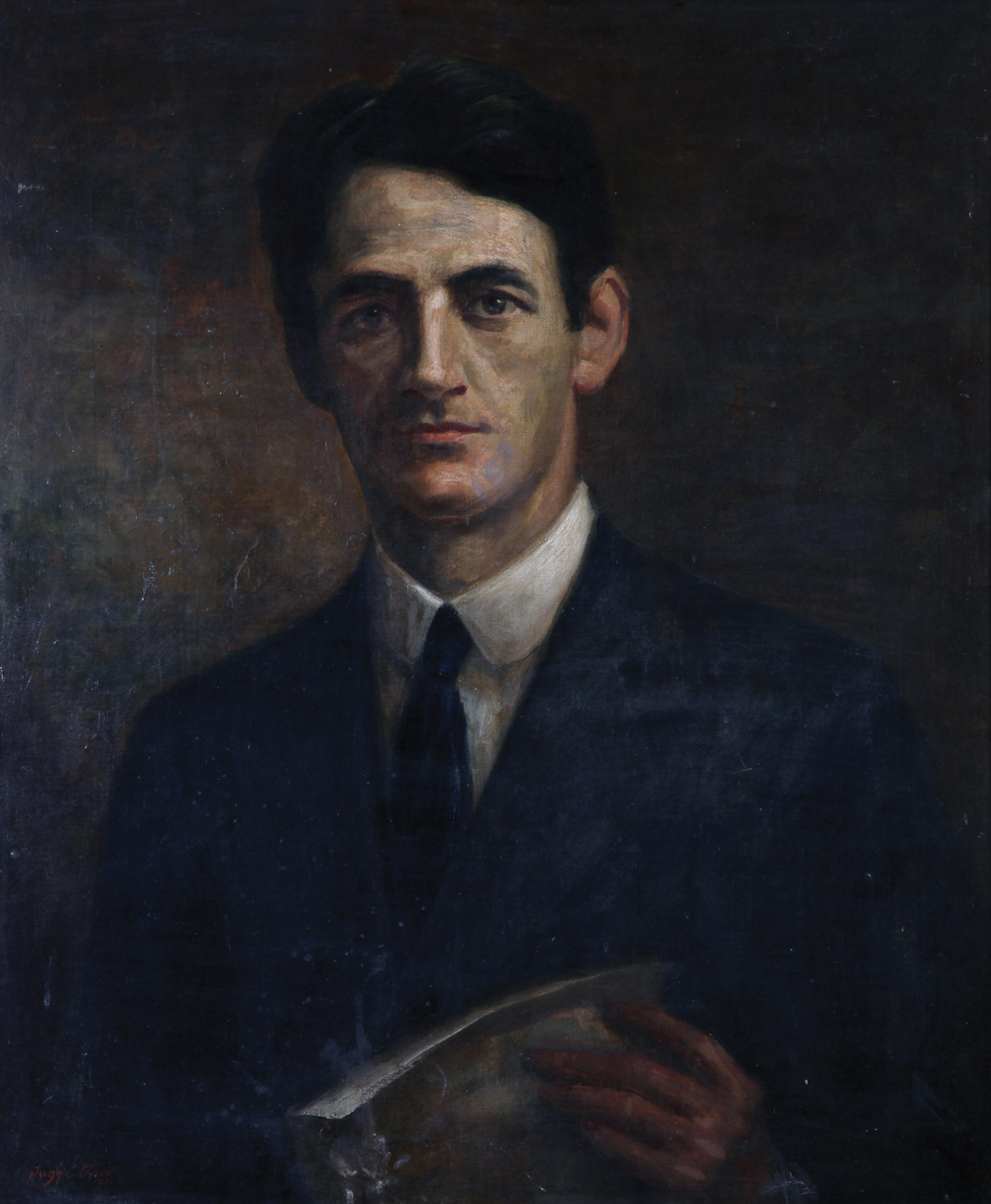
Hugh C. Charde, Portrait of Terence MacSwiney, Lord Mayor of Cork, 1920, oil on canvas, Crawford Art Gallery
Government of Ireland Act 1920 creates parliament in Belfast for six counties of ‘Northern Ireland.’ The establishment of a similar parliament in Dublin for the remaining 26 counties is boycotted by nationalists
Arrival of the ‘Black and Tans,’ former British Army soldiers, recruited to reinforce the Royal Irish Constabulary as the War of Independence continues
Terence McSwiney, Lord Mayor of Cork, dies on hunger strike in Brixton Prison
Artist Mary Swanzy joins the selection committee of the Société des Artistes Indépendants in France
Society of Dublin Painters founded
Artists Evie Hone and Mainie Jellet travel to Paris
1920
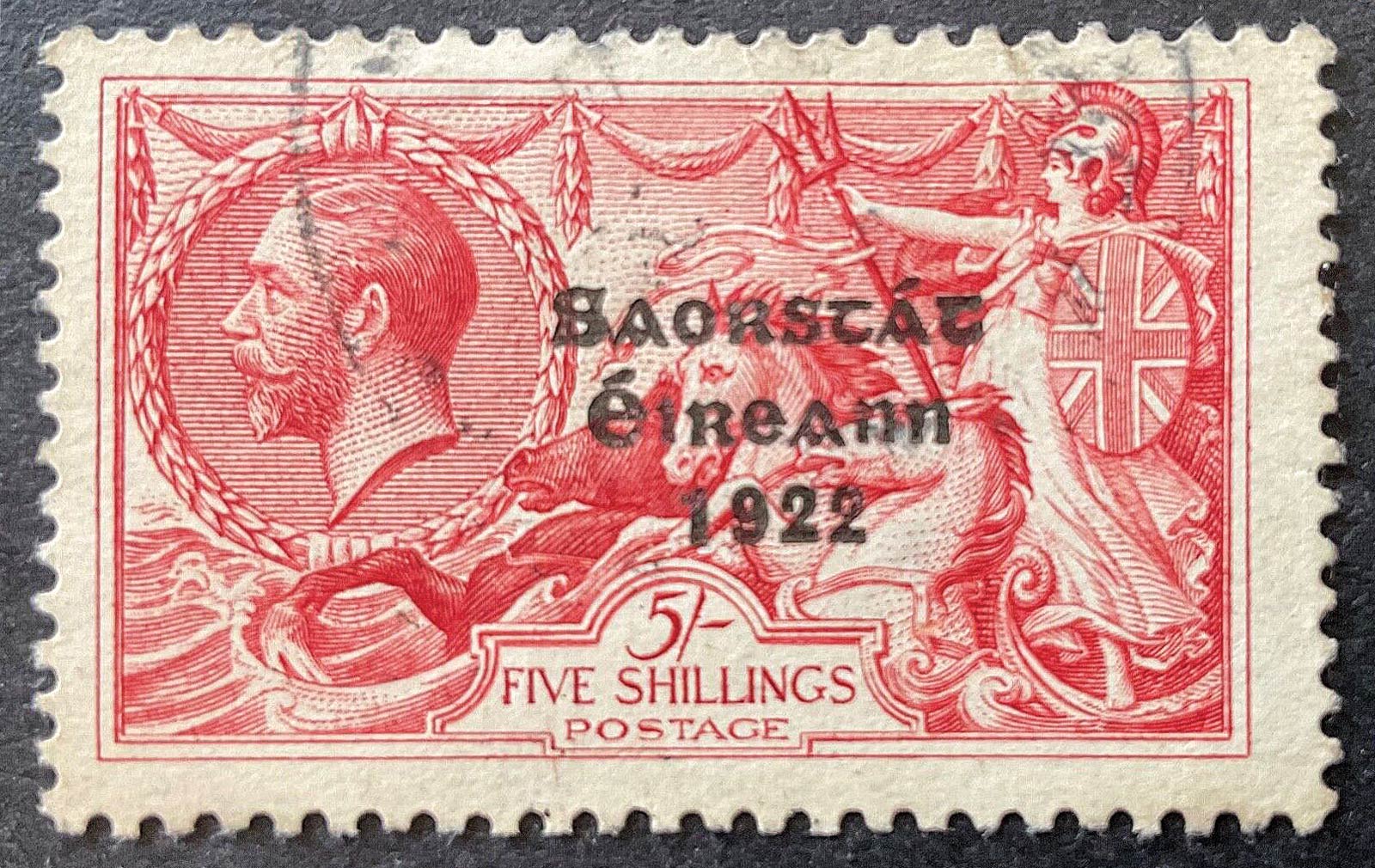
Overprinted Saorstát Éireann 1922 banknote
IRA burn the Custom House in Dublin, destroying local government records
War of Independence ends with July Truce
Sir James Craig appointed first Prime Minister of Northern Ireland
Anglo-Irish Treaty signed in London after intensive negotiations
The partition of Ireland and the the creation of Northern Ireland comes into effect under the Government of Ireland Act 1920
George Noble Plunkett appointed Minister for Fine Arts (1921–1922) in the first Dáil
Artist Cecil Ffrench Salkeld travels to Germany to study at the Kunstakademie, Kassel
1921
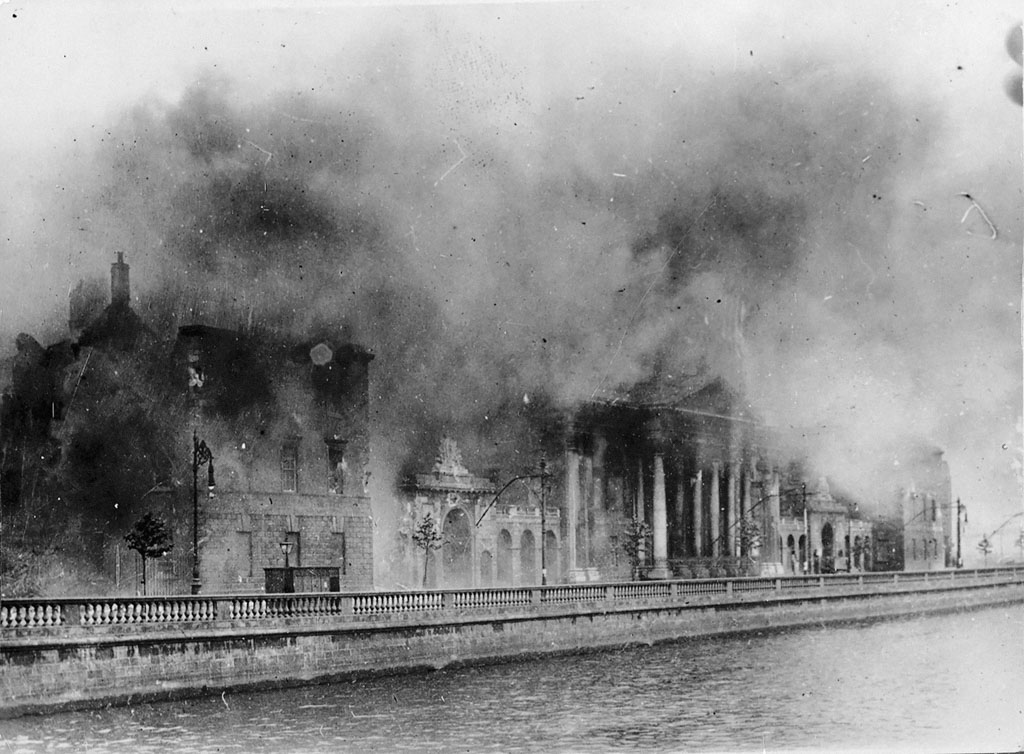
The Four Courts in Dublin during the Battle of Dublin, 1922, National Library of Ireland
Dáil Eireann passes the Anglo-Irish Treaty by 64 votes to 57, despite opposition led by Éamon de Valera
Provisional Government of Ireland formed to govern the Irish Free State, extending across 26 counties
Pro-Treaty candidates win majority of seats in General Election
The Constitution of the Irish Free State is adopted by Dáil Éireann
Irish Civil War begins as Treaty opponents reject compromises around sovereignty and partition
Death of Arthur Griffith
Michael Collins shot dead in Cork
The first Irish Free State stamp is issued, featuring a map of the island of Ireland with no border marked
James Joyce’s Ulysses published in Paris
John Lavery paints Michael Collins (Love of Ireland)
Exhibition of Irish artists at the Irish Race Congress in Paris
Aonach Tailteann, Great Exhibition of Irish Art
1922
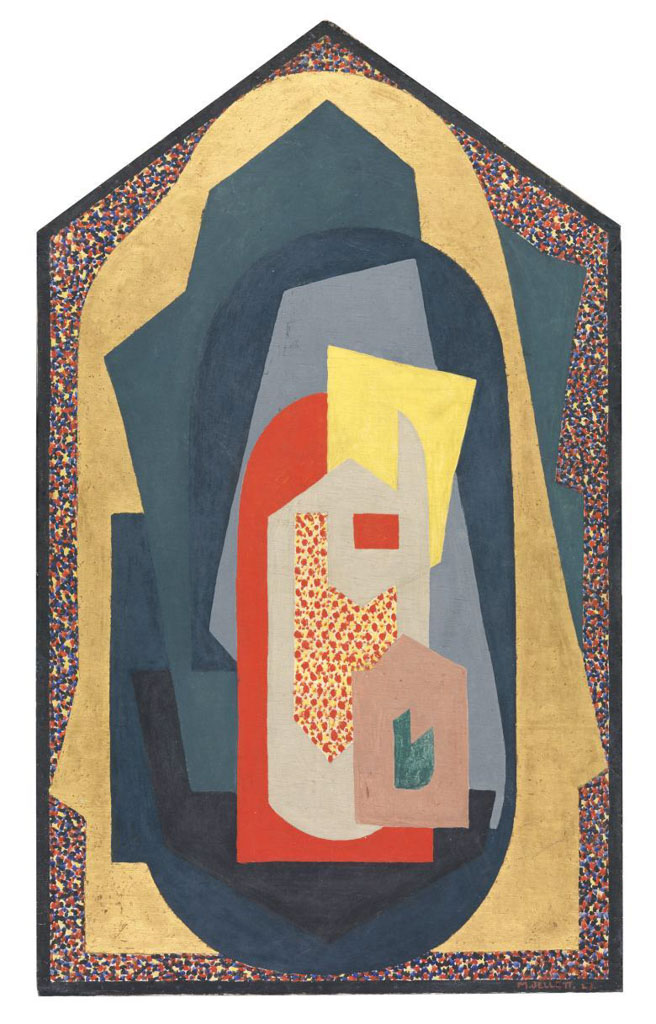
Mainie Jellett, Decoration, 1923, tempera on panel, National Gallery of Ireland
Fighting in the Civil War ends
Irish Free State joins the League of Nations
Censorship of Films Act introduced
Mainie Jellett exhibits cubist artwork Decoration at Society of Dublin Painters exhibition
Seán O’Casey’s The Shadow of a Gunman opens at the Abbey Theatre
W. B. Yeats becomes the first Irish person to win the Nobel Prize for Literature
Artist Sarah Purser becomes the first woman to join the Royal Hiberian Academy
Dublin Magazine founded by Seumas O’Sullivan
1923
First meeting of the Boundary Commission to examine the border between Northern Ireland and the Irish Free State
Amnesty for crimes committed during the Civil War as prisoners released from prison
An Garda Síochána established
Jack B. Yeats wins silver medal at the Olympic Games in Paris for The Liffey Swim
Tailteann Games, a major sporting and cultural festival, are held in Dublin
Sarah Purser founds the Friends of the National Collections of Ireland (FNCI)
1924
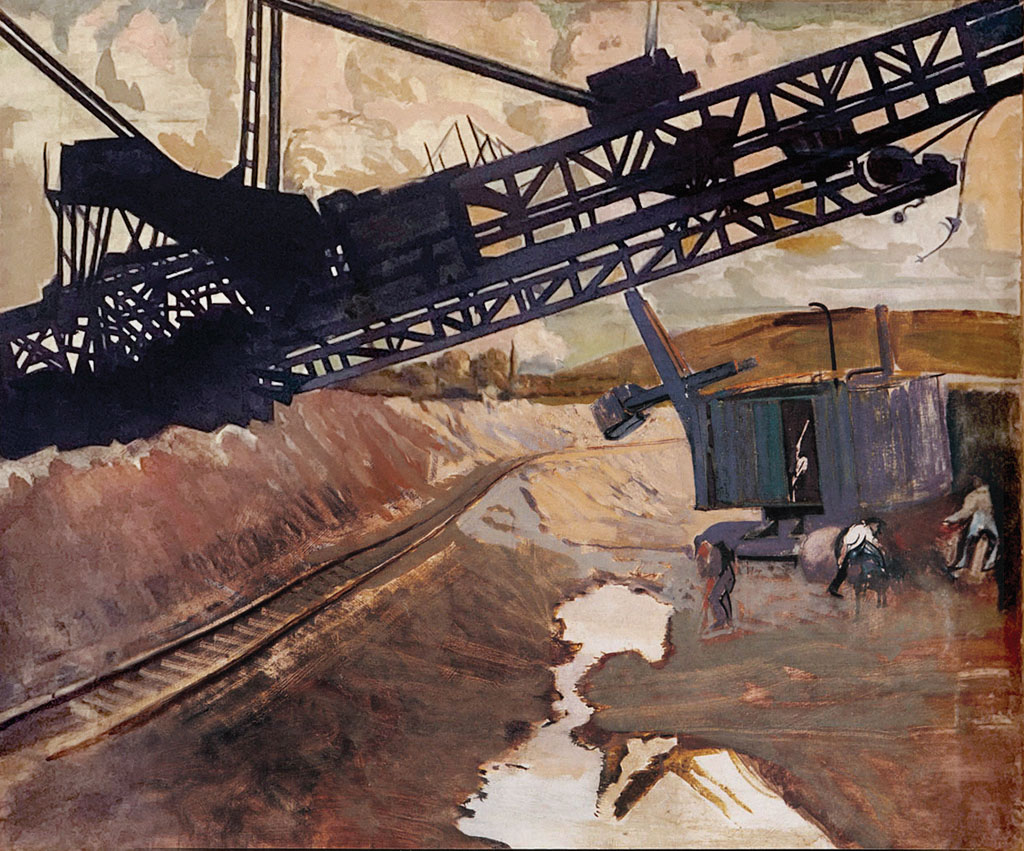
Seán Keating, Upstream of Powerhouse with Drilling Gang and Wagon Train, ESB art collection
Boundary Commission ends with no change to border between north and south
Civil Service Amendment Act gives government power to bar women from certain civil service exams
Shannon Hydro-Electric Scheme initiated to create power plant at Ardnacrusha, Co. Clare
George Bernard Shaw wins the Noble Prize for Literature
Liam O’Flaherty’s The Informer is published
The Radical Club is founded by Liam O’Flaherty with Cecil Ffrench Salkeld to promote cultural expression and solidarity among artists, writers and poets
Victor Waddington Gallery opens in Dublin
1925
2RN, the national radio station of the Irish Free State, makes its first broadcast
Fianna Fáil party founded under the leadership of Éamon de Valera
Emergency Powers Act introduced in Northern Ireland
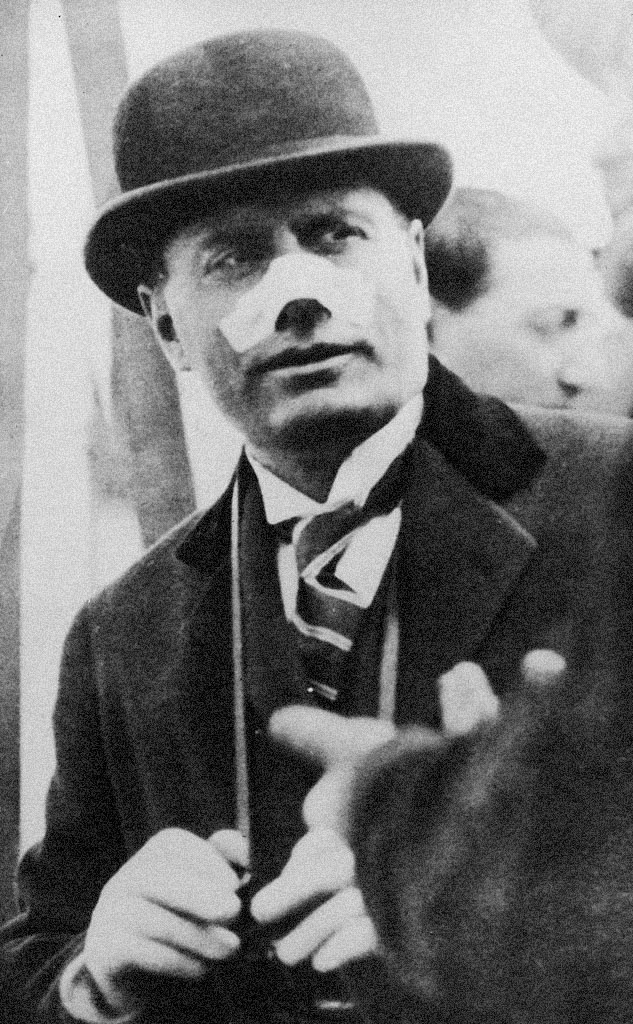
Benito Mussolini injured after an assassination attempt by Violet Gibson in 1926
Irish woman Violet Gibson attempts to assassinate Benito Mussolini by shooting at him in Rome
Seán O’Casey’s The Plough and the Stars opens at the Abbey Theatre
Seán Keating commissioned to create art works documenting the Shannon Hydro-Electric Scheme including Upstream Powerhouse with Drilling Gang and Wagon Train
Eileen Gray begins work on her house E-1027 in the South of France
Harry Clark commissioned by the Irish state to create a stained glass window in the League of Nations building in Geneva, but the government rejects the work
1926

Stella Steyn, Flower Seller, cover design for Dublin Civic Week 1927 Official Handbook, ed. Bulmer Hobson, Courtesy of the National Library of Ireland
Kevin O’Higgins, Minister for Justice, assassinated by Republicans
Compulsory attendance at school for children aged between 6 and 14 under the School Attendance Act
Death of Constance Markievicz
Electricity Supply Board established
First of the Cummann na mBan ‘Ghost’ pamphlets (1927–31) drawing attention to the invisibility of women in the new Free State
1927
Col. James Fitzmaurice, then officer-in-command of the Irish Aer Corps, Capt. Hermann Koehl and Baron von Huenefeld, complete the first east to west transatlantic flight from Baldonnel aerodrome to Greenly Island, Quebec, in the Bremen, a Junkers W33 single-engine monoplane
Gate Theatre founded in Dublin
Taibhdhearc na Gaillimhe, Irish Language theatre, opens in Galway
First banknotes and coinage of the Irish Free State issued
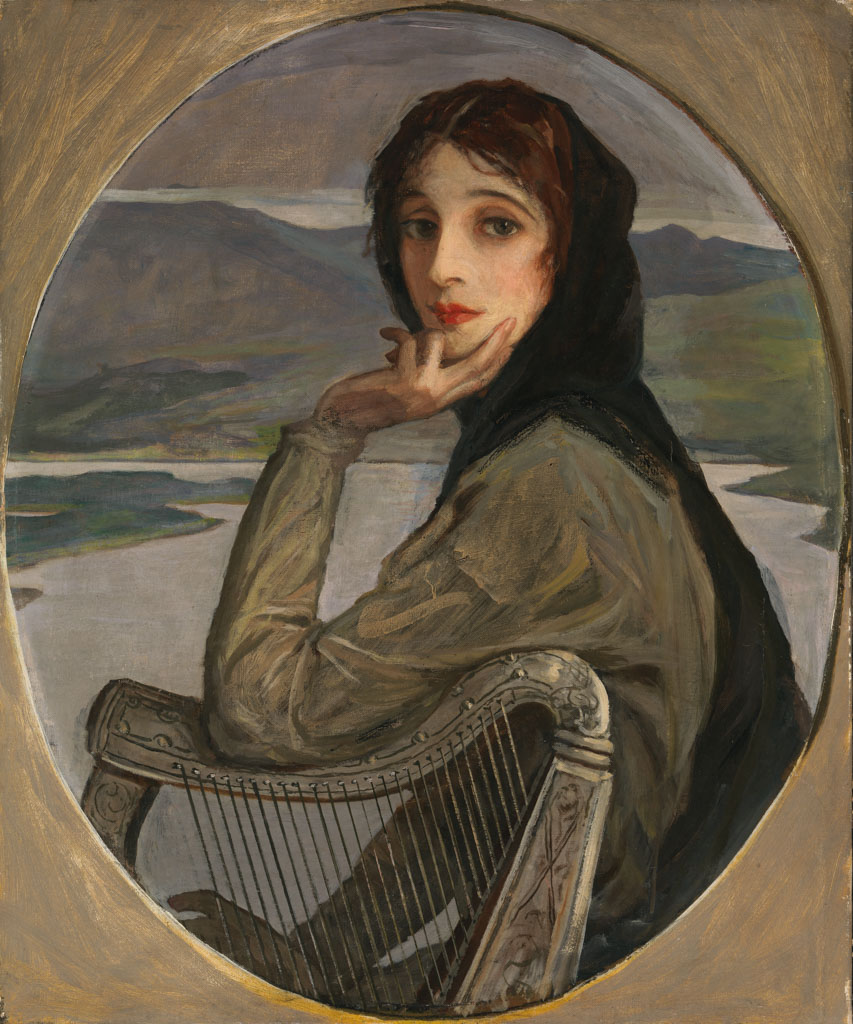
John Lavery, Lady Lavery as Kathleen Ni Houlihan, 1928, National Gallery of Ireland
Artist John Lavery paints Portrait of Lady Lavery as Kathleen Ni Houlihan for the new bank notes of the Irish Free State
Second Tailteann Games held in Dublin
1928
PR (Proportional Representation) abolished for parliamentary elections in Northern Ireland
Centenary of Catholic Emancipation marked by countrywide festivities
Rebuilt GPO (General Post Office) opens on O’Connell Street in Dublin
Ardnacrusha Hydro-Electric power station opens
Censorship of Publications Act bans sale and distribution of ‘indecent or obscene’ books, and the advertising of contraception or abortion
Tomás Ó Criomhthain’s An tOileánach, published
The Academy of Christian Art opens
1929
The first Irish Sweepstakes draw takes place
National Monuments Act passed to allow for the preservation and protection of national monuments and archaeological objects
1930
Muintir na Tíre, a national organisation promoting community development in Ireland, founded by Canon John Hayes
First edition of the Irish Press newspaper printed
An Óige, the Irish Youth Hostel Association, established to encourage appreciation of the Irish countryside through walking and cycling
The Four Courts re-opens, having been slowly rebuilt after extensive damage during the Civil War
Orson Welles performs at the Gate Theatre
Artist Stella Steyn studies at the Bauhaus Design School, Dessau, Germany
1931
First Fianna Fáil government formed under Éamon de Valera
Northern Ireland parliament moves to new purpose-built Parliament Buildings at Stormont
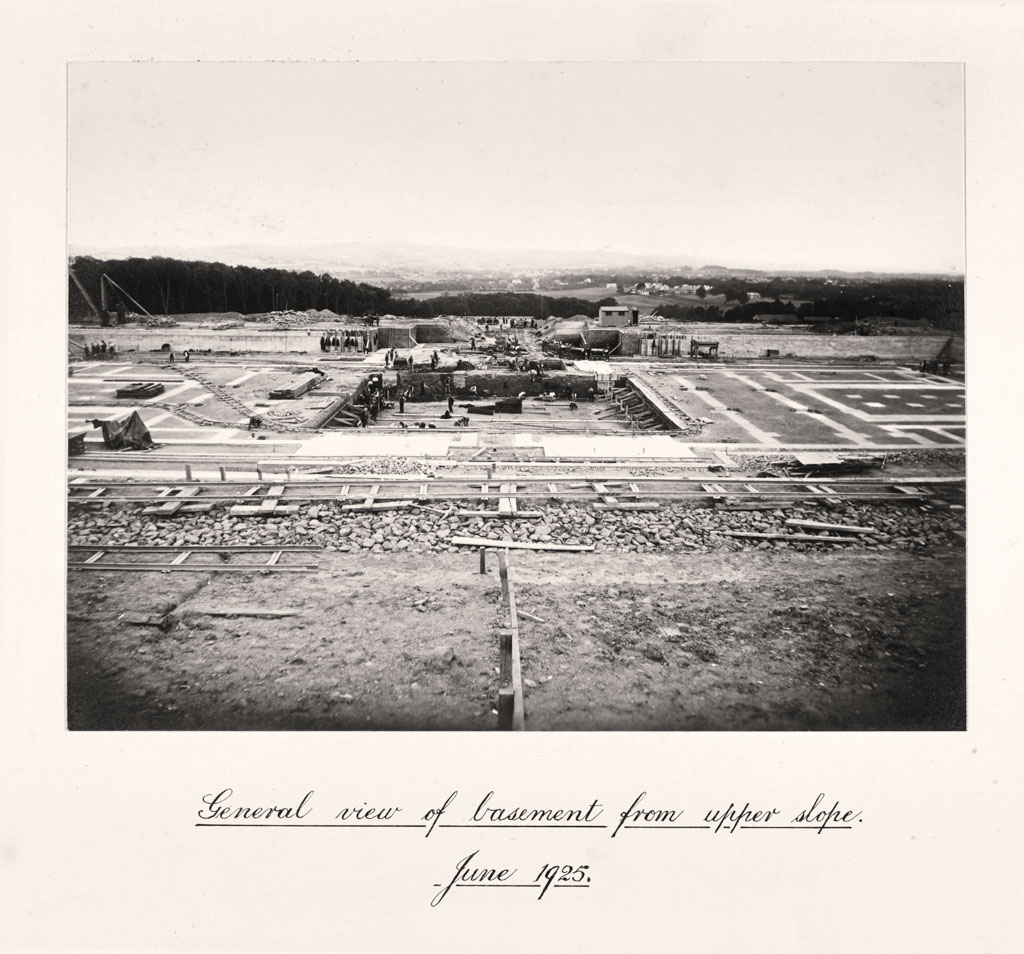
Storemont under construction. Steel reinforcement for tower foundation, July 1925. Image courtesy of the Deputy Keeper of the Records, Public Record Office of Northern Ireland (CWPB/1/1)
Academy of Irish Letters established to oppose the Censorship of Publications Board
The Anglo-Irish Trade War begins
Amelia Earhart’s first solo transatlantic flight by a woman ends in Derry
31st International Eucharistic Congress held in Dublin, involving pilgrims from more than 100 countries
Third and final Tailteann Games held in Dublin
Army Comrades Association (The Blueshirts) founded
1932
Fine Gael party founded, initially known as United Ireland Party
‘Blueshirts’ are proclaimed an unlawful association
Municipal Gallery of Modern Art opens in Dublin
1933
Anti-Jazz campaign led by the Gaelic League gathers momentum
Republican Congress founded by Peader O’Donnell, George Gilmore and Charlie Donnelly
Premiere of Robert Flaherty’s film Man of Aran
Revised Programme of Primary Education introduced to enhance position of Irish language and Irish history in the curriculum
1934
The Death of Cúchulainn, by Oliver Sheppard, installed in GPO to commemorate 1916 Rising
Criminal Law Amendment Act makes contraception illegal
The Conditions of Employment Act extends the marriage bar for women to the entire civil service
Irish Folklore Commission set up to collect material on the folklore and traditions of Ireland
Death of Unionist leader, Edward Carson
Dance Halls Act restricts public behaviour in dance halls
Sean O’Casey’s Silver Tassie performed at the Abbey Theatre
John Lavery bequeaths 35 paintings to the Hugh Lane Municipal Gallery of Modern Art
1935
IRA declared illegal in Irish Free State
Frank Ryan leads followers to fight for the Republican Government in Spain, while General Eoin O’Duffy brings others to fight for General Franco after the Spanish Civil War begins
Inaugural Aer Lingus flight departs Dublin for Bristol
Ernie O’Malley’s On Another Man’s Wound is published
1936
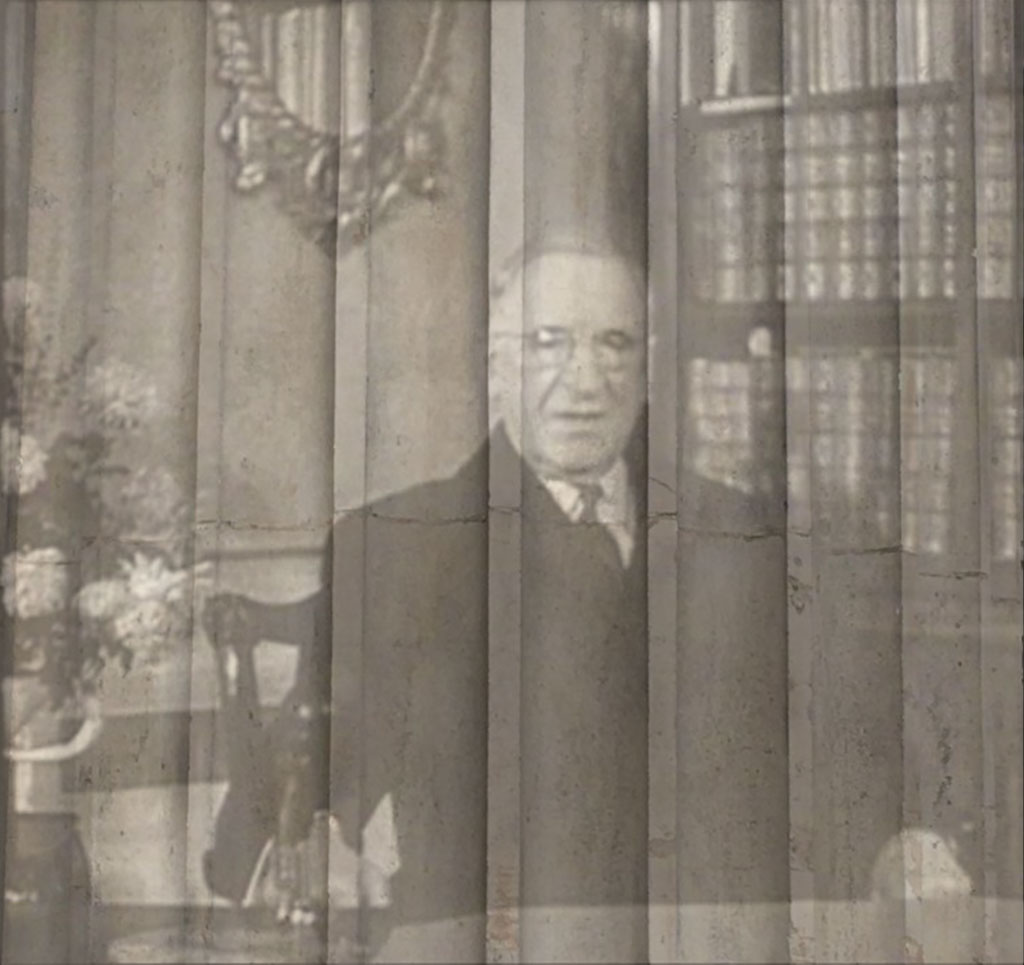
Clíodhna Ní Anluain, Still from Pillar Talk featuring an image of Éamon de Valera, 2022
Éamon de Valera becomes first Taoiseach
New Constitution of Ireland (Bunreacht na hÉireann) replaces the Irish Free State with Éire/Ireland, prohibits divorce and acknowledges the exceptional status of the Catholic Church in Ireland
The poet and republican Charlie Donnelly dies fighting for the International Brigade in Spain
Statue of King George II, erected in 1758 on St Stephen’s Green, blown up by Republicans
King George VI and Queen Elizabeth visit Belfast
National Radio Station renamed as Radio Éireann
Ireland’s first traffic lights installed in Dublin on Merrion Square
Exhibition of Polish Art and Design at Mill’s Hall, Merrion Row, Dublin
French poet Antonin Artaud is deported from Ireland
1937
Academic and politician Douglas Hyde elected unopposed as the first President of Ireland
Anglo-Irish agreement signed to end the trade war and the Irish government takes control of the ‘Treaty Ports’ of Berehaven, Spike Island and Lough Swilly
Éamon de Valera elected President of the Assembly of the League of Nations
Samuel Beckett’s Murphy published
Contemporary Picture Galleries founded by Moira Pilkington under the pseudonym of Deirdre McDonagh
1938
State of emergency declared under Emergency Powers Act as Germany invades Poland to start World War II
Irish Government adopts a policy of neutrality during World War II
Irish Government formally recognises government of General Franco
Irish Republican Army begins bombing campaign in England
Evie Hone designs The Four Green Fields for Irish Pavilion at the New York World’s Fair 1939
Flann O’Brien’s At Swim-Two-Birds is published
James Joyce’s Finnegans Wake is published
Death of W. B. Yeats
The Contemporary Picture Gallery hosts an exhibition of Irish and international art including works by Juan Gris, Pablo Picasso, and Georges Braques, Jack B Yeats, Eva Hamilton, Norah McGuinness, and Harry Kernoff
Victor Waddington brings works by Irish artists to New York to coincide with the New York World’s Fair 1939 and the opening of the new Museum of Modern Art Goodwin/Stone building
1939
CREDITS
INTERNATIONAL
Norway women get the right to vote
Woodrow Wilson inaugurated as President of the US
Second Balkan War as nation states continue to emerge from the territories of the Ottoman Empire
Assassination of Archduke Franz Ferdinand of Austria, in Sarajevo, by Gavrilo Princip, a Bosnian Serb student, leads to outbreak of World War I
The Central Powers (including Germany, Austria-Hungary, Bulgaria and the Ottoman Empire) fight against the Allied Powers (including the UK, France, Russia, Italy, Romania, Canada, Japan and the United States), with countries involved in the conflict at different stages across four years
Norway, Sweden and Denmark declare neutrality
Vladimir Lenin publishes The Right of Nations to Self-Determination
France declares war on Bulgaria
Lithuania occupied by German troops
The Armenian Genocide, a campaign of mass murder and genocide of the Armenian people, begins in the Ottoman Empire
Gallipoli campaign begins when Allied armies invade a peninsula in the Ottoman Empire
Cleveland Agreement between Czech and Slovak national organisations pledging cooperation in support of independent statehood
Denmark women get the right to vote
Treaty of London, secret agreement between the UK, France, Russia, and Italy where Italy is promised territories from the Austro-Hungarian and Ottoman Empires, and from Africa, for its allegiance in World War I
France Battle of the Somme leaves more than one million men dead or injured
Austria-Hungary death of Emperor Franz Joseph
Sykes-Picot Agreement, secret plans for the partition of the Ottoman Empire into French and British zones of influence after the war ends, going back on promises to support Arab self-determination
Arab Revolt against the Ottoman Empire begins
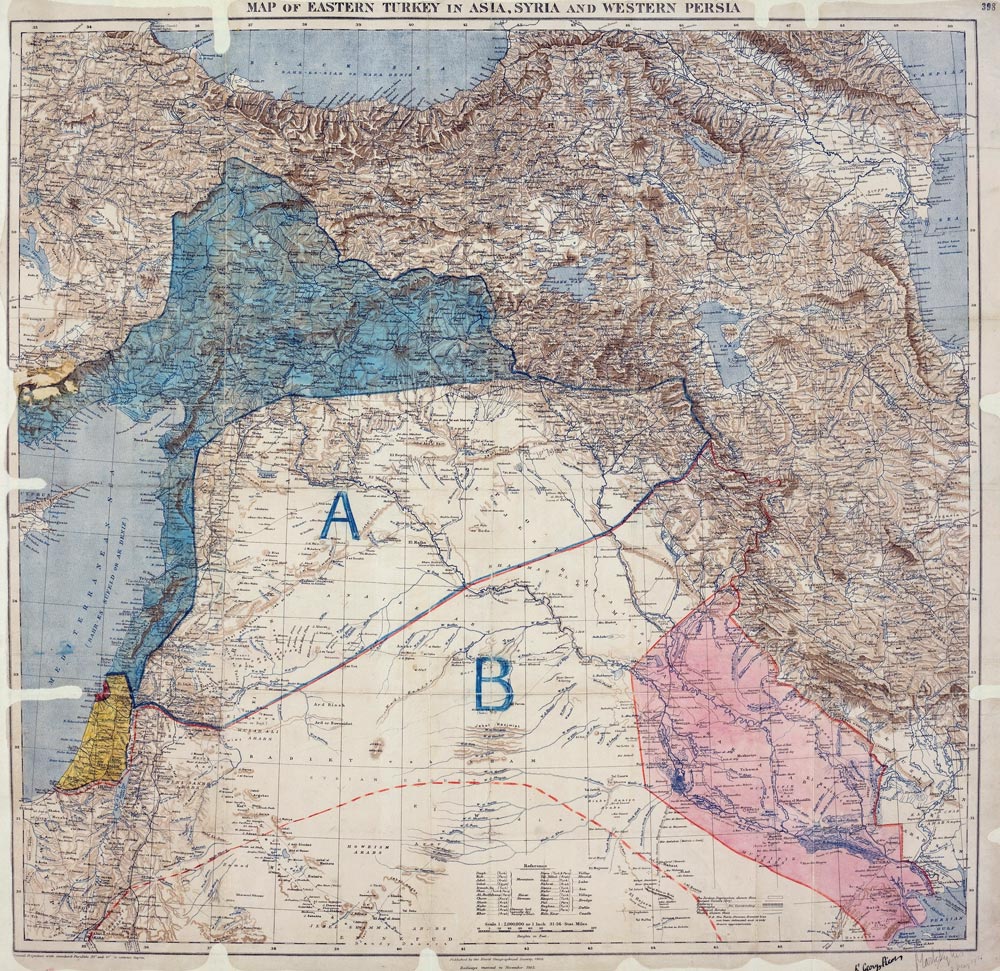
Map of the Sykes-Picot Agreement showing areas of control and influence secretly agreed between the British and French 1910–15. National Archives, UK.
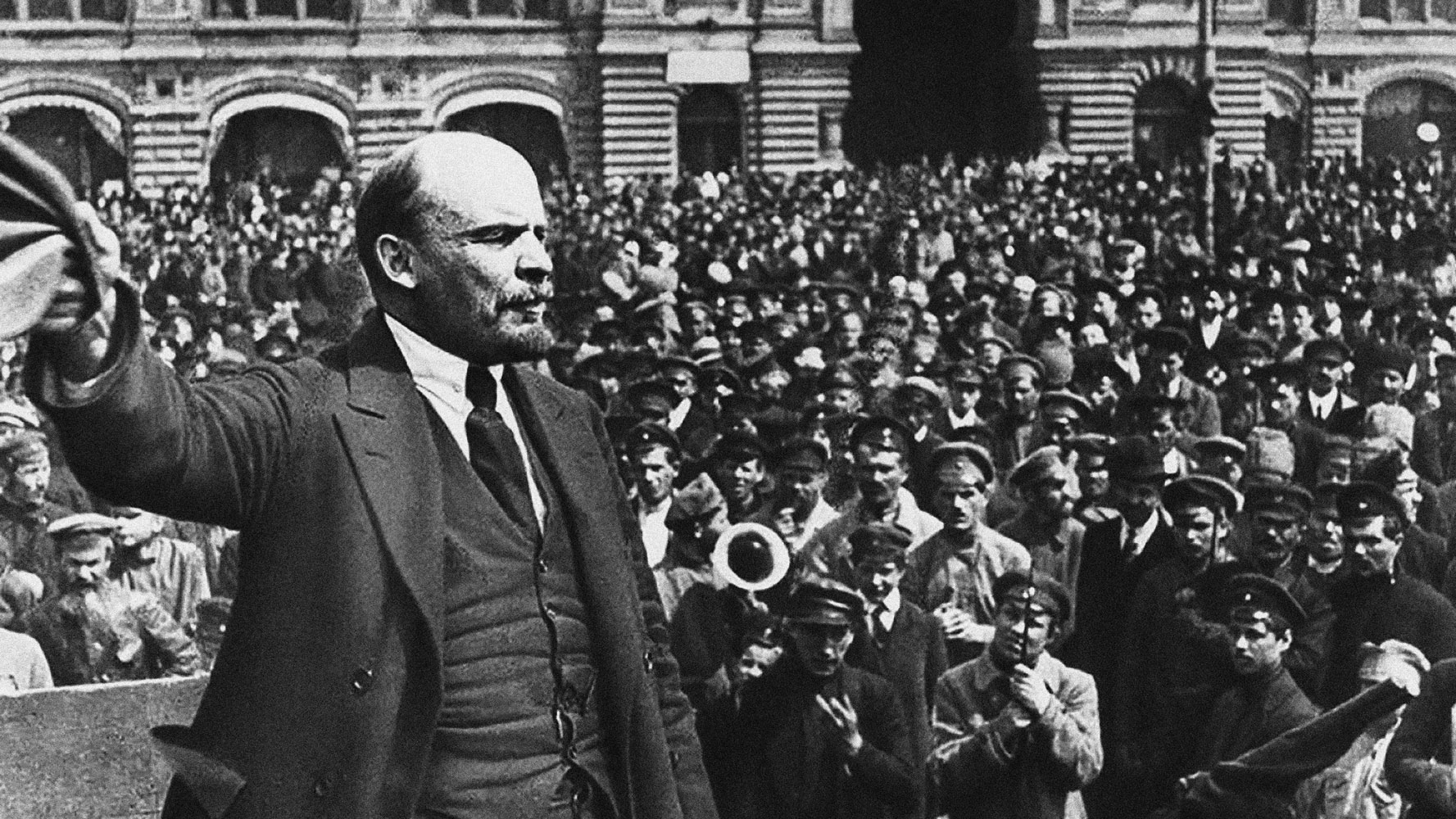
Lenin speaks to the public during the 1917 revolution, image: public domain
Russia the Russian Revolution sees Tsar Nicholas II abdicate and soviets established across the country
Finland declares independence from Russia
Ukraine Central Council of Ukraine proclaims the formation of the Ukrainian People’s Republic, creation of first Ukrainian government and beginning of war of independence
US declares war on Germany
France army mutinies
Palestine Balfour Declaration offers statement of British support for ‘the establishment in Palestine of a national home for the Jewish people’
Russia beginning of civil war and pogroms targeting Jewish people living in the former Russian Empire which continue into 1920
Poland first exhibition of Polish Expressionists at The Kraków Society of Friends of Fine Arts
Ukraine establishment of the Women’s Union of Ukraine
US President Woodrow Wilson introduces his Fourteen Points plan for the postwar peace to Congress, including the concept of national self-determination
Treaty of Brest-Litovsk between Soviet Russia and Central Powers enabling Soviet Russia to withdraw from war
Armistice of Mudros ends Ottoman Empire involvement in World War I
Armstice between Germany and Allied Powers ends World War I in Western Europe
Austria, Germany, Hungarian Republic, Poland,Sweden women get the right to vote
Poland regains independence and establishes Second Polish Republic
Ukraine Ukrainian People’s Republic declares independence from Russia, creation of a Ukrainian state
Estonia, Latvia and Lithuania declare independence from Russia
Germany establishment of the Weimar Republic
Finland Civil War leaves more than 30,000 dead
Beginning of Polish-Ukrainian War
Austria establishment of Republic of German-Austria
United Kingdom Representation of the People Act sees women over 30 who met a property qualification get the right to vote
Influenza epidemic sweeps the world killing an estimated 50 million people
Kingdom of Serbs, Croats, and Slovenes established
Czechoslovakia established as Austro-Hungarian Empire collapses
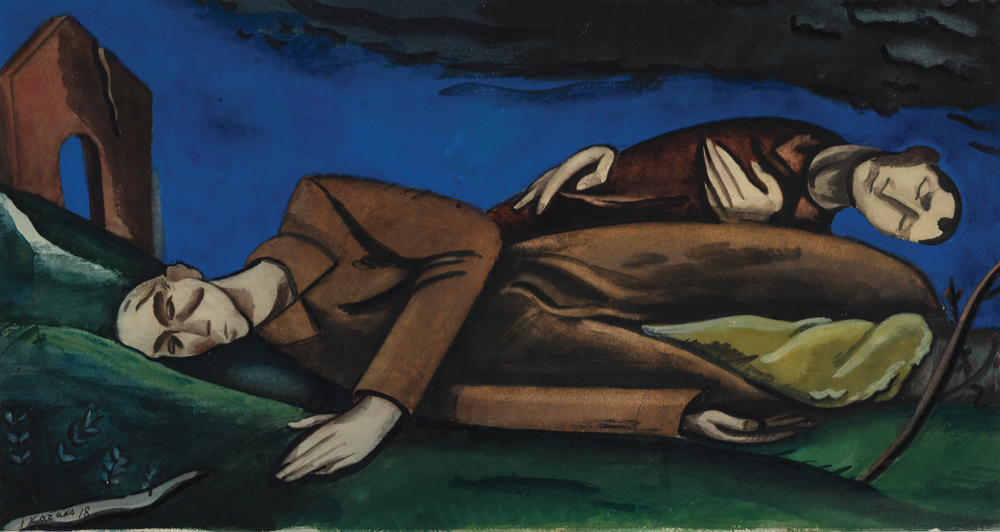
Jekabs Kazaks, I laid my head on the boundary line, 1918, tempera on board, Latvian National Museum of Art
The Paris Peace Conference convenes at Versailles to establish the terms of the peace after World War I and ends with the Treaty of Versailles
Treaty of Saint-Germain-en-Laye between Allies and Austria establishes new order of Central Europe, recognising the establishment of independent states from the former Austro-Hungarian Empire
Treaty of Neuilly-sur-Seine between Allies and Bulgaria, which cedes territory to neighbouring countries, including Greece
Finland constitution signed
Italy gains Trentino, South Tyrol and Trieste from the former Austro-Hungarian Empire
Afghanistan gains independence from the UK
Austria first Austrian Republic established
Turkey formation of Turkish National Movement and War of Independence begins
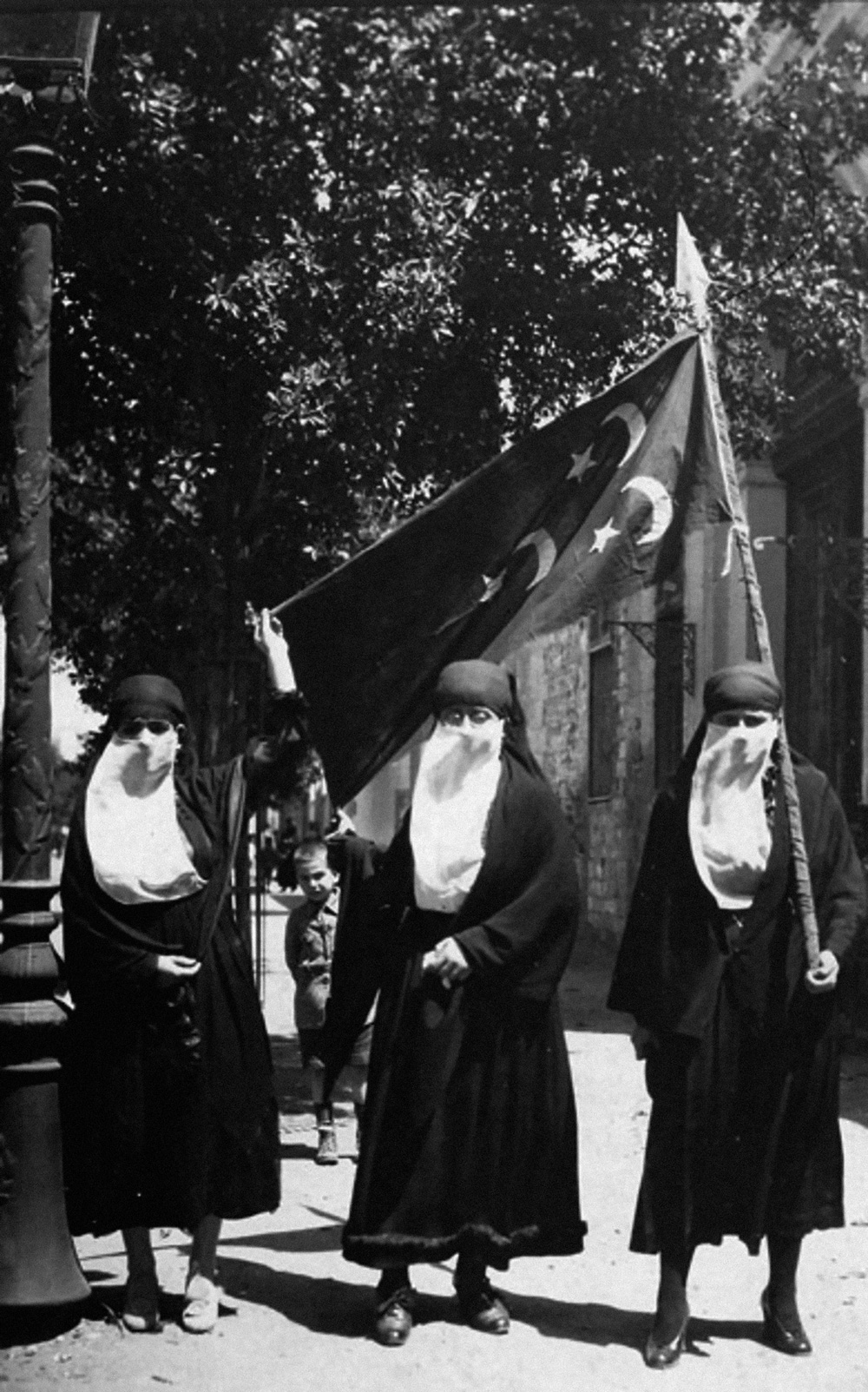
Nationalists demonstrating in Cairo, 1919
Egypt revolution against British rule begins
Estonia Pallas Art School established
Germany Bauhaus School founded by architect Walter Gropius
Treaty of Sèvres partitions the Ottoman Empire and gives control of much of its territory in the Middle East and Africa to France, the UK, Greece and Italy
Treaty of Trianon sets new borders for Hungary
League of Nations assembles in Geneva
Finland, Austria and Bulgaria join League of Nations
Latvia peace treaty with Soviet Russia recognises Latvian independence
Lithuania signs peace treaty with Soviet Russia
Estonia Soviet Russia recognises Estonian independence
Finland Tartu Peace Treaty confirms border between Soviet Russia and Finland
Treaty of Warsaw, alliance between Second Polish Republic and the Ukrainian People’s Republic against Soviet Russia
Latvia first exhibition of the Riga Artists Group
Little Entente, alliance formed between Czechoslovakia, Romania and the Kingdom of Serbs, Croats and Slovenes to resist threat from any Habsburg restoration in Austria or Hungary
UK Cenotaph by Edwin Lutyens unveiled in London
Soviet RussiaVkhutemas – Higher State Artistic and Technical Workshops founded in Moscow
Germany Hitler becomes leader of the Nazi party
France Burial of ‘Unknown Soldier’ under the Arc de Triomphe
Treaty of Ankara ends Franco-Turkish War
Estonia, Latvia and Lithuania join League of Nations
Treaty of Moscow establishes friendly relations between Turkey under Mustafa Kemal (later named Kemal Atatürk) and Soviet Russia under Vladimir Lenin
Morocco war between Berber peoples and Spanish colonialists
Iraq The UK combines provinces of Basra, Bagdad and Mosel changing the name from Mesopotamia to Iraq and installs Faisel I as King
Treaty of Rapallo sees Germany recognise Soviet Russia and formal diplomatic relations are opened
Italy Benito Mussolini becomes Prime Minister
UK British Broadcasting Company founded and launches first radio broadcasts
Poland first exhibition of the RYTM Group (1922–1932)
Declaration and Treaty on the Formation of the Union of Soviet Socialist Republics (USSR), known as the Soviet Union
Ukraine following a brief period of independence and civil war the Ukrainian People’s Republic becomes the Ukrainian Soviet Socialist Republic as part of the Soviet Union
Turkey burning of the port city of Smyrna leaves thousands of mainly Greeks and Armenians dead
End of Greco-Turkish War, leading to ‘population exchange’ between Greece and Turkey, with new borders being agreed
Egypt gains limited independence from the UK
Hungary joins League of Nations
Turkey Republic established and its borders are recognised by the Treaty of Lausanne
Germany hyperinflation in the Weimar Republic and Beer Hall Putsch, coup attempt by the Nazi party fails
French and Belgian troops occupy the Ruhr Valley after Germany defaults on reparation payments
Egypt foundation of the Egyptian Feminist Union
Estonia Group of Estonian Artists cubist-constructivists registered
Abyssinia joins League of Nations
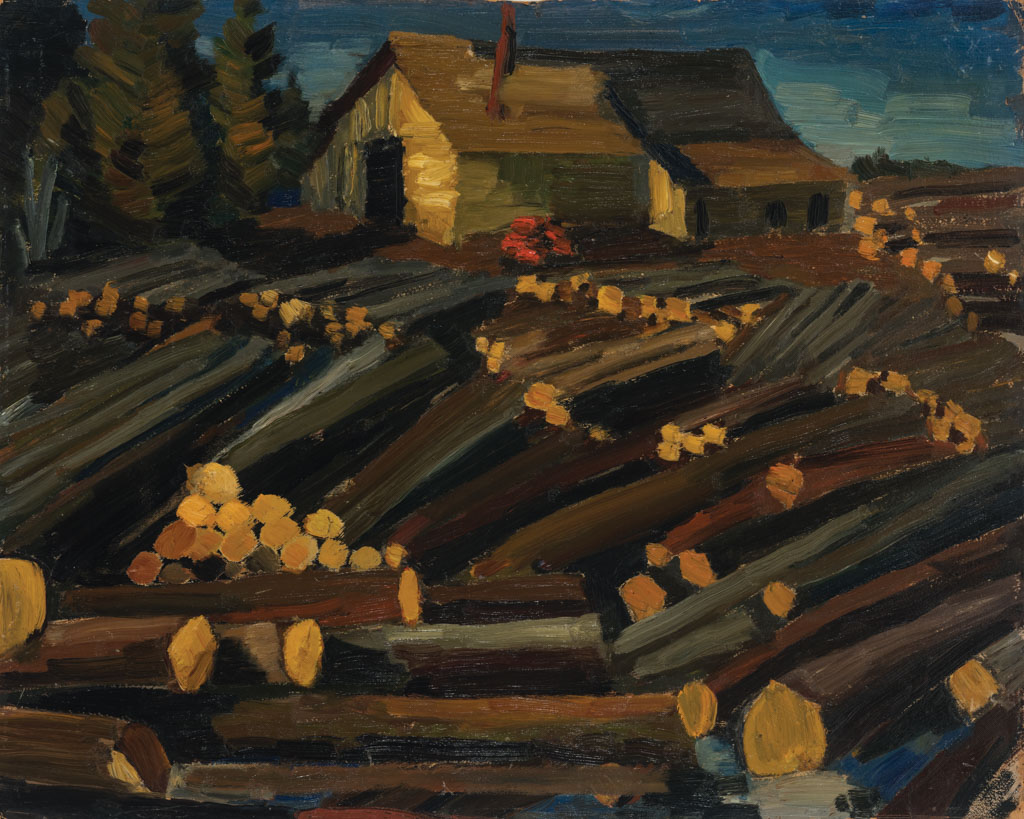
Leo Svemps, Logs at the Sawmill, 1923, oil on canvas, Latvian National Museum of Art
Soviet Russia St Petersburg, having been renamed Petrograd a decade earlier, is now renamed Leningrad after the death of Lenin
Yugoslavia first Constructivist exhibition
Blok Group of Cubists, Constructivists and Suprematists formed in Poland (1924–26)
Germany agreement over reparations leading to end of occupation of Ruhr
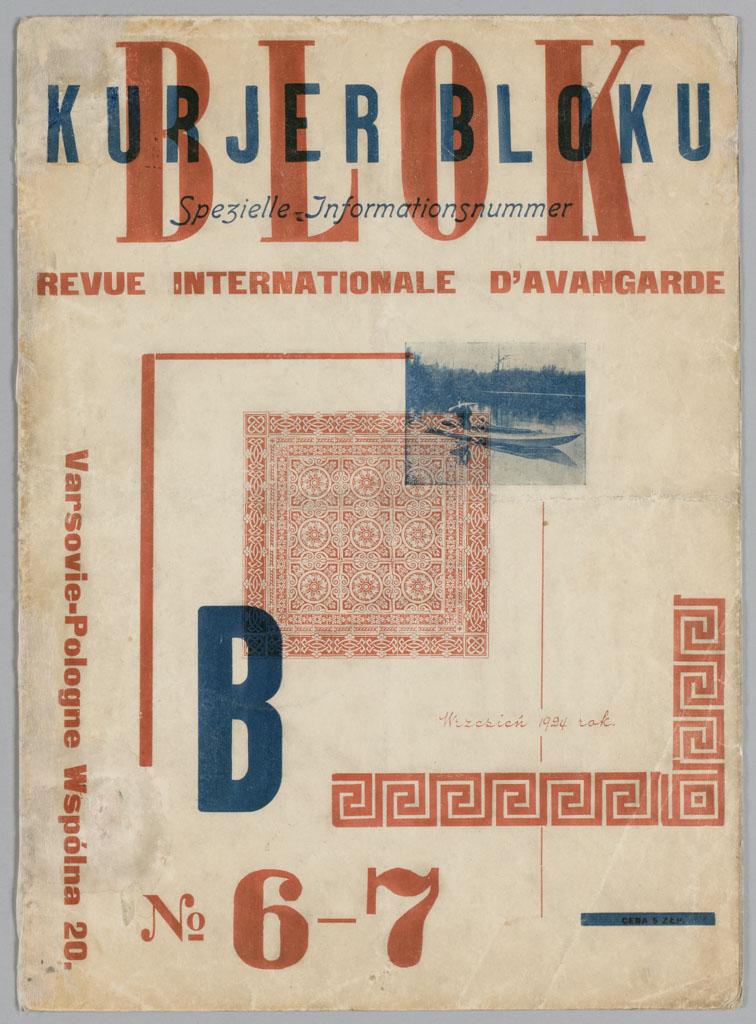
Blok 6–7: Kurjer Bloku, cover design by Mieczysław Szczuka, (1924)
Locarno Treaties agreement of post-war territorial settlement between Belgium, the UK, Czechoslovakia, France, Germany, Italy and Poland
Turkey Sheikh Said rebellion of Kurdish nationalists
Syria state of Syria established as a French Mandate
France the International Exhibition of Modern Decorative and Industrial Arts takes place in Paris
Lithuania military coup sees Antanas Smetona establish authoritarian rule
Poland military coup as Marshal Józef Piłsudski establishes authoritarian rule
UK general strike as millions of workers take to the picket lines in response to pay cuts and poor working conditions
Portugal military coup allows General António Oscar de Fragoso Carmona to become president
Germany joins League of Nations
Poland Praesens group of artists and architects established
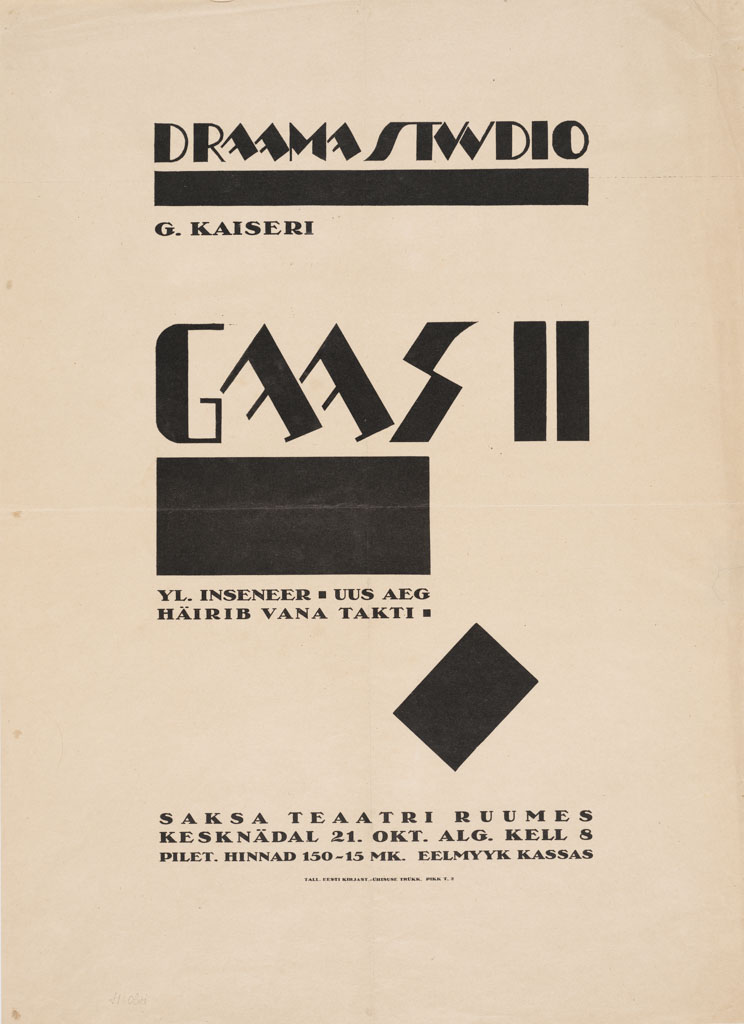
Henrik Olvi, G. Kaiseri ‘Gaas II’ poster design for Draamastudio of Georg Kaiser’s Gas, print on paper, 1926. Art Museum of Estonia (KUMU)
First solo, nonstop transatlantic flight from New York to Paris by Charles Lindberg in the Spirit of St. Louis
Soviet Russia Leon Trotsky is expelled from the Soviet Communist Party as Joseph Stalin consolidates his hold on power in the Soviet Union
UKraine construction begins on the Dnieper Hydroelectric Station in Zaporizhzhia
UK Equal Franchise Act – all women over 21 get the right to vote
Kellog-Briand Pact attempts to prevent any further global war through the General Treaty for Renunciation of War as an Instrument of National Policy
Turkey modified Latin alphabet introduced and state declared secular
Albania republic replaced by a monarchy of King Zog I
Egypt unveiling of Mahmoud Mukhtar’s Egypt Awakening sculpture
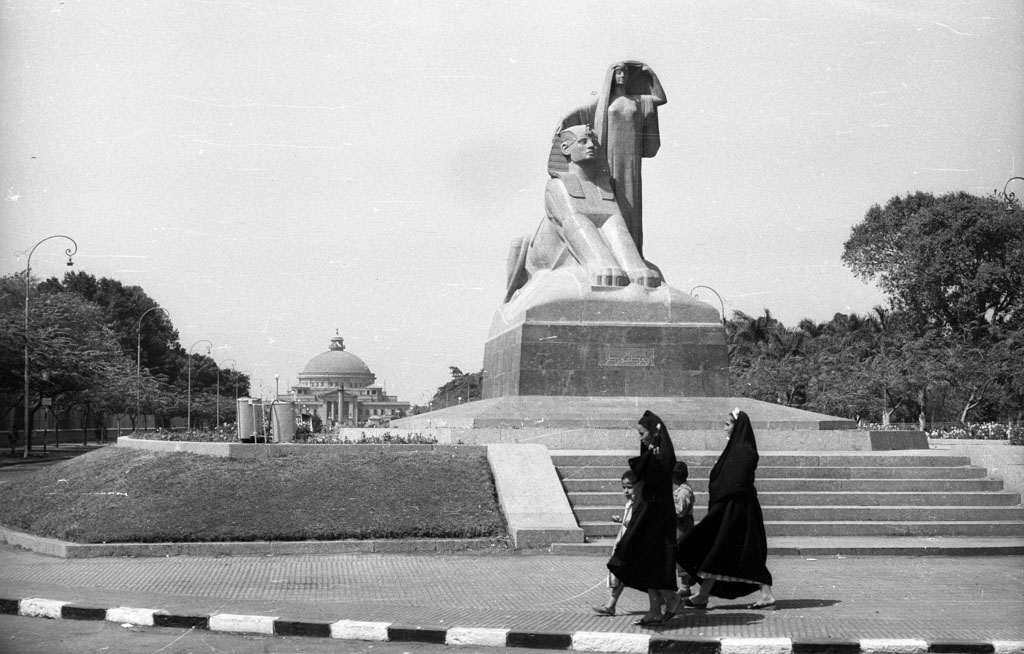
Mahmoud Mokhtar, Nahdat Misr (Egypt Awakened/ Egypt Renaissance), 1928, Sculpture
Wall Street Crash, American stock market crashes as value of shares collpases amid panic
Yugoslavia Kingdom of Serbs, Croats, and Slovenes adopts Yugoslavia as its name and Royal Dictatorship of King Alexander established
Poland a.r. group of artists established
Turkey Independent Painters and Sculptors Union established
Germany Gustav Stresemann, German Foreign Minister, dies
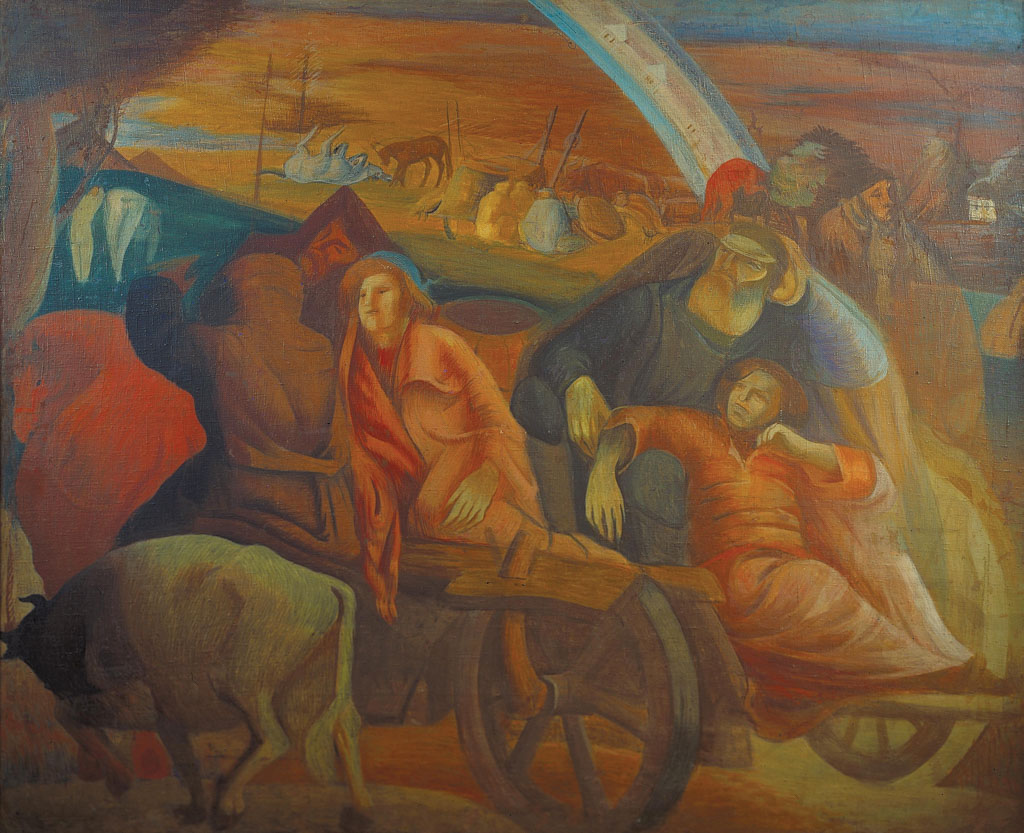
Emanuil Shechtman, Emigrants, 1929, tempera on canvas, NAMU
French troops withdraw from the Rhineland, where they had been based since the Treaty of Versailles
Turkey renames Constantinople as Istanbul
Turkey The State Art and Sculpture Museum opens in Ankara
The inaugural FIFA World Cup is held in Uruguay and is won by the hosts who defeated Argentina in the final
Sigmund Freud’s Civilisation and its Discontents is published
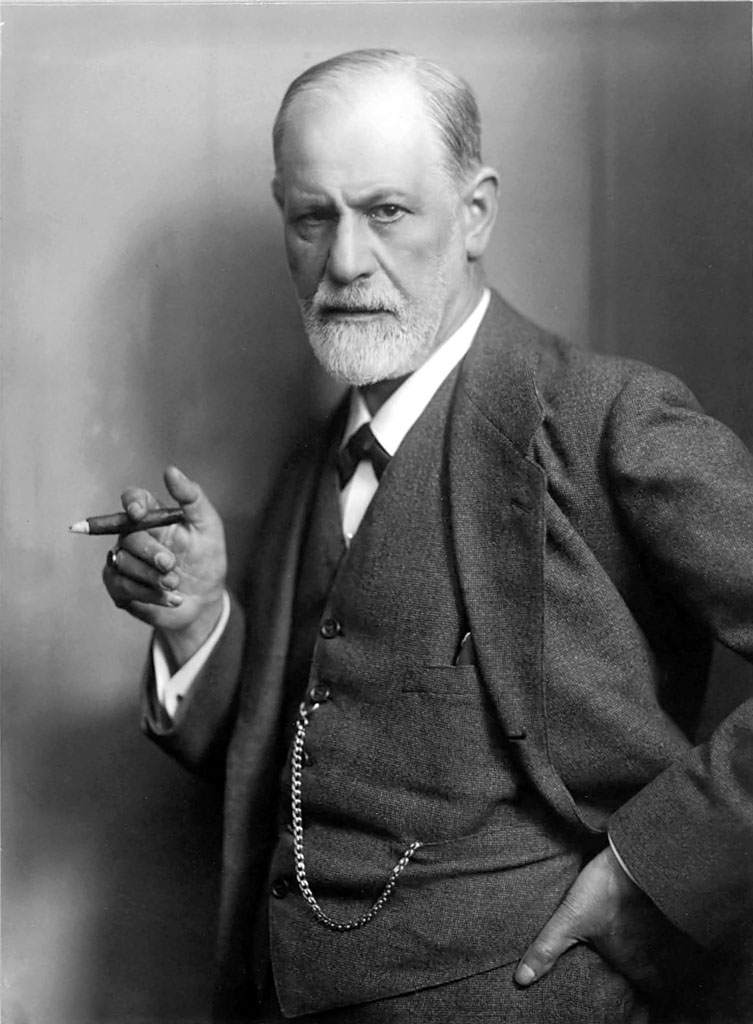
Sigmund Freud, c. 1921. Photo: Max Halberstadt
Spain Second Spanish Republic established after a landslide victory for Republicans in a General Election
Statute of Westminster establishes the legislative equality of the self-governing dominions of the Commonwealth of Australia, Canada, the Irish Free State, Newfoundland, the Dominion of New Zealand and the Union of South Africa
Portugal António de Oliveira Salazar becomes prime minister
Ukraine millions die in man-made famine known as the Holodomor during 1932 and 1933 as part of Stalin’s collectivisation and centralisation policies
Iraq becomes an independent state
Turkey and Iraq join League of Nations
Germany Nazi Party becomes the largest party in the Reichstag
Austria Engelbert Dollfuss appointed Chancellor and moves to establish an autocratic regime
Kurdistan first issue of Hawar Magazine published in Damascus, featuring a newly-produced Kurdish alphabet designed by Celadet Alî Bedirxan
Germany Hitler appointed Chancellor of Germany
Germany The Reichstag is burned down
Turkey Group D – artist union established
Germany Bauhaus School closes due to pressure of Nazi party
Finland completion of construction of the Paimio Sanatorium, designed by Alvar and Aino Aalto
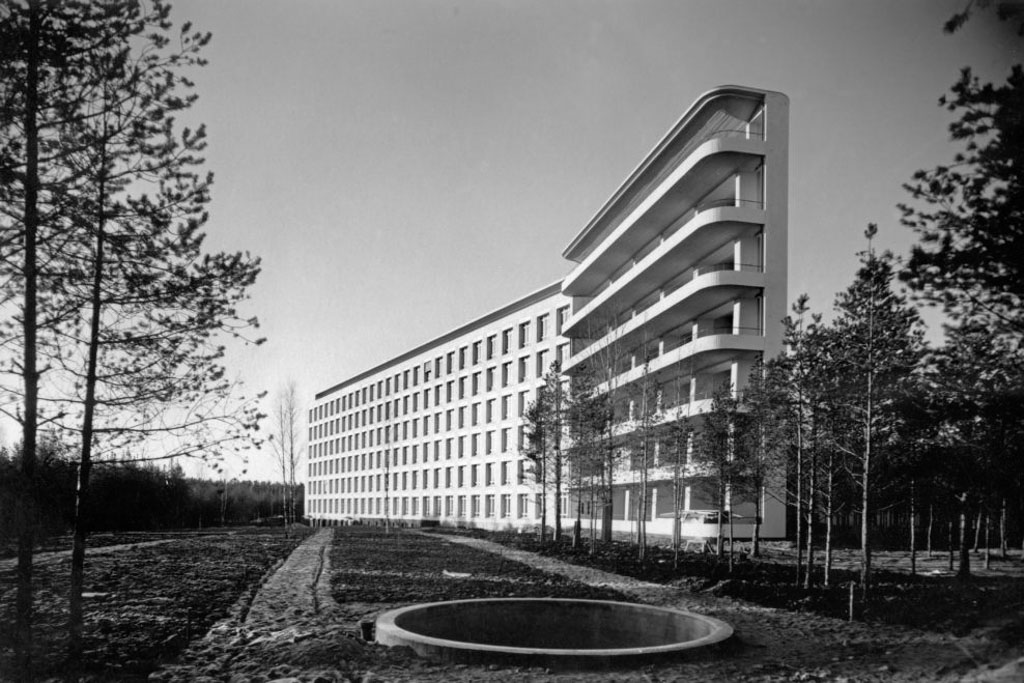
Alvar and Aino Aalto, Paimio Sanatorium, patient wing with sun terraces in 1930s, photo Gustaf Welin
Germany Night of the Long Knives consolidates Hitler’s hold on power
Bulgaria coup d’état installs Kimon Georgiev as prime minister
Latvia coup d’état establishes authoritarian rule of Karlis Ulmanis
Austria brief civil war ends in decisive victory for government troops
Yugoslavia King Alexander of Yugoslavia assassinated in France while meeting French foreign minister, Louis Barthou, who is also shot dead
Germany and Poland sign non-aggression pact
Germany Hitler declares himself Führer of Germany
Soviet Union joins League of Nation
Libya Italy merges its three colonial territories in North Africa – Cyrenaica, Tripolitania and Fezzan – to create Libya
Estonia preemptive self-coup by the Prime Minister of Estonia, Konstantin Päts
Ukraine first Ukrainian Women’s Congress takes place in Ivano-Frankivsk, at that time part of Poland
Italy invades Ethopia
Mussolini-Laval Accords see France and Italy settle disputes in Africa and respect each other’s colonial territories
Germany announces rearmament in contravention of the Treaty of Versailles
Germany antisemitic and racist Nuremburg laws enacted in Germany
Poland death of Józef Piłsudski in Warsaw
Spain Civil War begins
Germany Olympic Games staged in Berlin
Italy and Germany align foreign policy
UK King George V dies, Edward VIII abdicates, George VI becomes King
Germany reoccupies the Rhineland
Poland approval of a Four Year Plan for the development of the Central Industrial District
Baltic Entente Treaty of Good-Understanding and Co-operation between Lithuania, Latvia and Estonia as a mutual-defence pact
Portugal Salazar backs Franco in Spanish Civil War
Egypt Anglo-Egyptian Treaty requires UK to remove all troops from Egypt except those guarding the Suez Canal
Syria Franco-Syrian Treaty of independence, not implemented by France
Germany Entartete Kunst exhibition of modern and contemporary art deemed ‘degenerate’ by the Nazi party
Pablo Picasso paints Guernica in response to Luftwaffe bombing of the city during the Spanish Civil War
Soviet Union Great Purge of enemies by Stalin’s regime
Egypt joins the League of Nations, while Italy withdraws
Germany Kristallnacht sees Nazis attack Jewish people and property
Estonia Konstantin Päts becomes president under new constitution
Germany Anschluss – Germany annexes Austria
Italy Mussolini demands France cede Tunisia, Nice, Corsica and French Somaliland to Italy
Munich Agreement – France, Germany, the UK and Italy agree to German annexation of Czechoslovakia’s Sudetenland
Turkey death of Mustafa Kemal Atatürk in Istanbul
Turkey first of the Painter’s Homeland Tours takes place, sending Turkish artists to document rural life in the regions
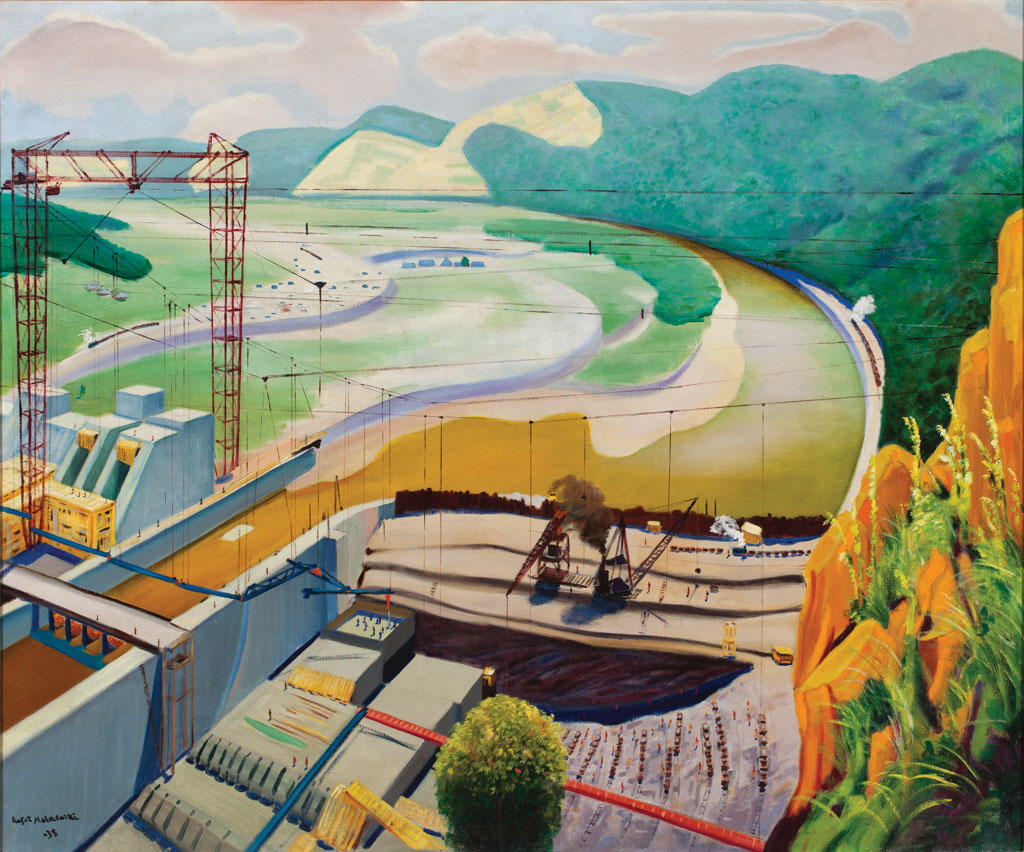
Rafal Małcsewski, Growing dam Roznów, oil on canvas, National Museum Warsaw
Sporazum agreement to address internal divisions in Kingdom of Yugoslavia results in creation of substate of Croatia
Estonia signs non-aggression pact with Germany
Pact of Steel – Germany and Italy form political and military alliance
Germany takes Memelland from Lithuania
Germany occupies Bohemia and Moravia
Molotov-Ribbentrop Pact – Germany and the Soviet Union agree a non-aggression pact and to divide the countries that lie between them
World War II begins as Germany invades Poland
Italy annexes Albania
Spain end of Civil War and start of reign of General Franco following defeat of Republican government
Soviet Union invades Finland and is expelled from League of Nations
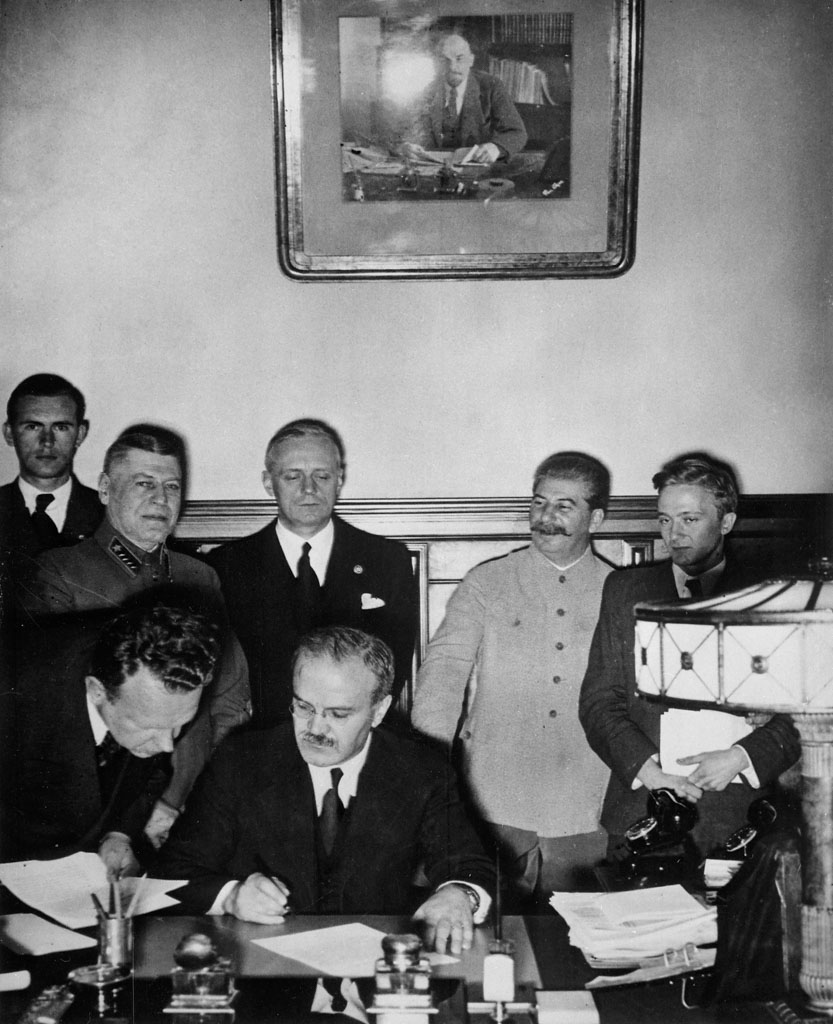
Molotov-Ribbentrop Pact, Vyacheslav Molotov, Russian foreign minister, signs the non-aggression pact negotiated between Soviet Russia and Germany, at the Kremlin, Moscow. Standing behind him is his German counterpart Joachim von Ribbentrop (left), and Joseph Stalin (centre). Image: public domain
Produced: Lisa Moran
Research: Ciara Magee, Stephen O'Neill, Stephen Taylor, Nathan O'Donnell, Kaitlin Cawley, Lisa Moran
Proofing: Marysia Wieckiewicz-Carroll and Nuria Carbelleira
Research Advisor: Paul Rouse
Design: Unthink





